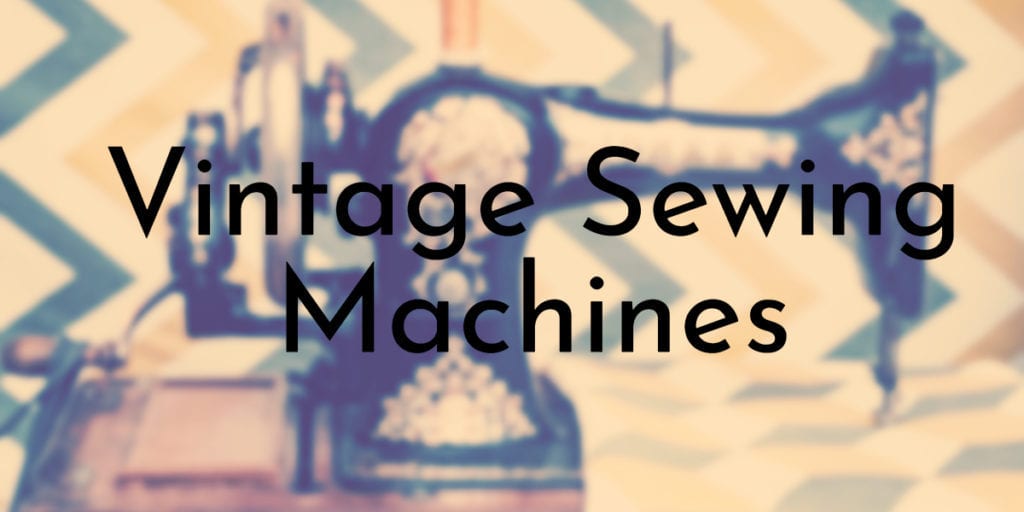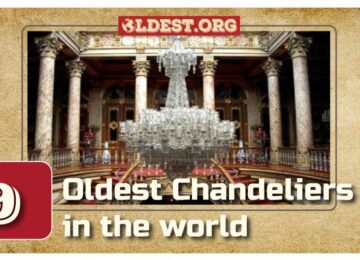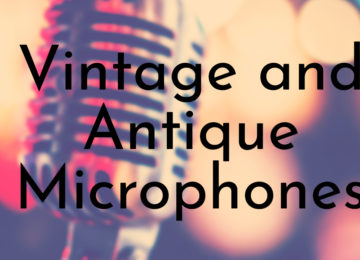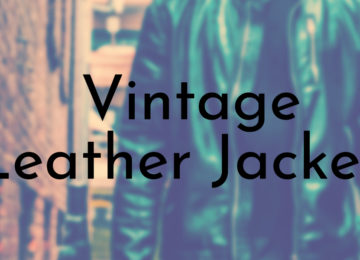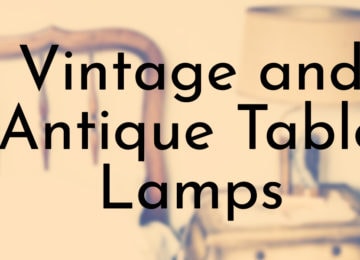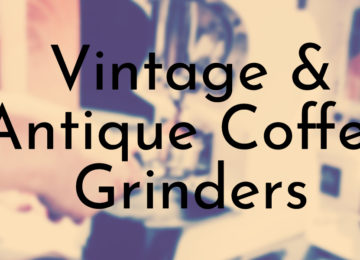Sewing machines have been around since the early 19th-century. Thanks to the solid construction standards of the era, many remain today as antique machinery. They’re not just rusted pieces of history, but usable (or renewable) assets for today’s sewing projects. Let’s take a closer look at where sewing machines started, how to make an informed purchase, and some excellent options to get you started on your search for your new-old sewing machine!
Table of Contents
Antique Sewing Machine Brands
Singer
Possibly the most well-known sewing machine brand, Singer has been around since the beginning of the sewing machine industry and remains a leading brand today. Singer machines—even early ones—can typical be found for around $150-200, although specialty models can reach $700.
Kenmore Sears
The first Kenmore sewing machine was produced in 1913, before being dropped in 1919. The Kenmore line sewing machines began again in 1933. They disappeared again during the war and reemerged for the 50s. Kenmore is the most expensive of the major brands, averaging $200-400.
Brother
Originally Yasui Sewing Machines, Co., the company that would come to be known as Brother was founded in Japan in 1908. The name emerged in the 1950s as a westernization effort as the company spread to a global marketplace. Brother tended to produce machines for other companies initially, so the early presence is difficult to trace. Late 20th-century variants labeled as Brother are generally between $100-150.
What To Look For In a Vintage Sewing Machine?
While you’re hunting, here are a few things to keep an eye out for …
- Check for damage: surface dings and scratches are inevitable, but do the mechanics still function?
- Is anything rusted; if so, what is the complexity to replace the damaged part(s)?
- Many sellers outline the current functionality of their machine; but if they don’t, ask questions!
- Make sure to check the machine if you need a specific type of stitch, antique machines often only have one type.
I) 1880s-1910s Sewing Machines
1. French Cast Iron Machine
Year: 1800s
Color: Black & Gold
Features: Hand-Crank
Condition: Incomplete
Price: $225
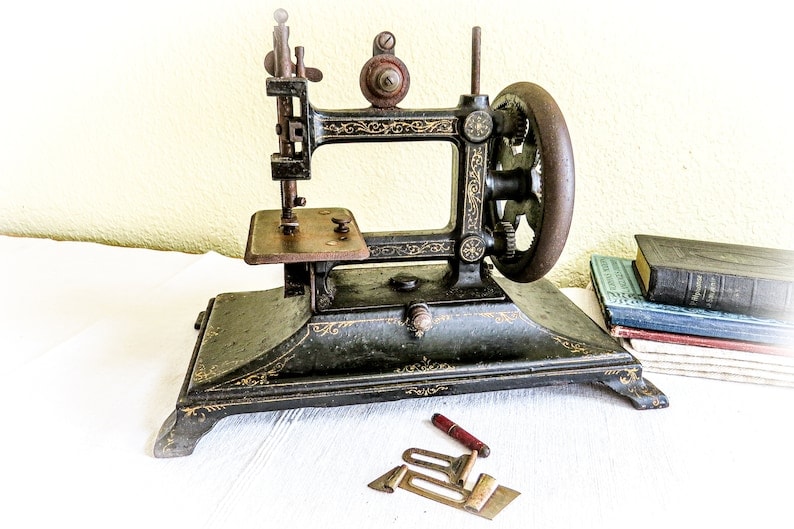
This is a rather amazing piece, a very early sewing machine before the design settled into the one shape most brands used through the 20th & 21st centuries. This machine is also in cast iron, which is an unusual material. The needle is broken and the knob on the wheel is missing, but otherwise the mechanics seem to be in operation.
2. Rare White Machine
Year: 1800s
Color: Black & Gold
Features: Hand-Crank
Condition: Incomplete
Price: $325
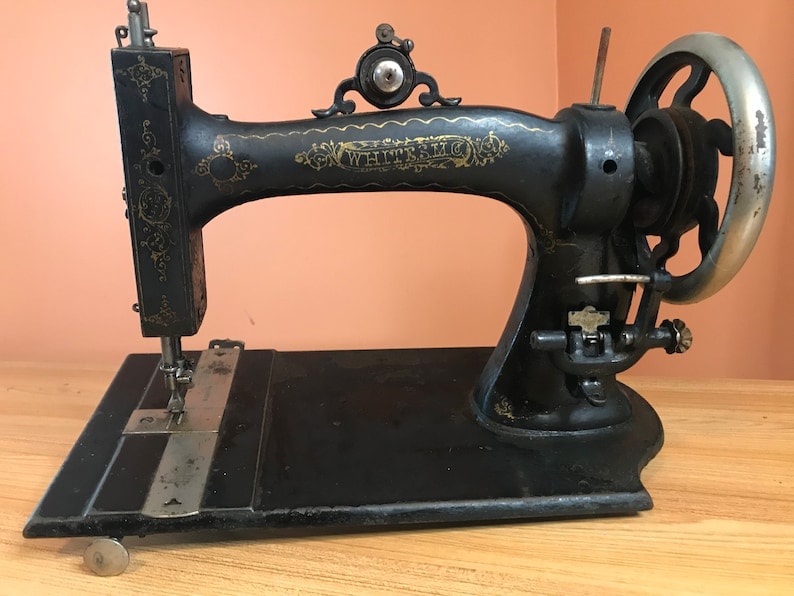
White is a long-standing brand, one of the brands that joined the 1856 conglomerate. The shuttle and needle are missing on this machine.
3. Singer Patented 1891
Year: 1890s
Color: Black & Gold
Features: Hand-Crank
Condition: Display
Price: $160
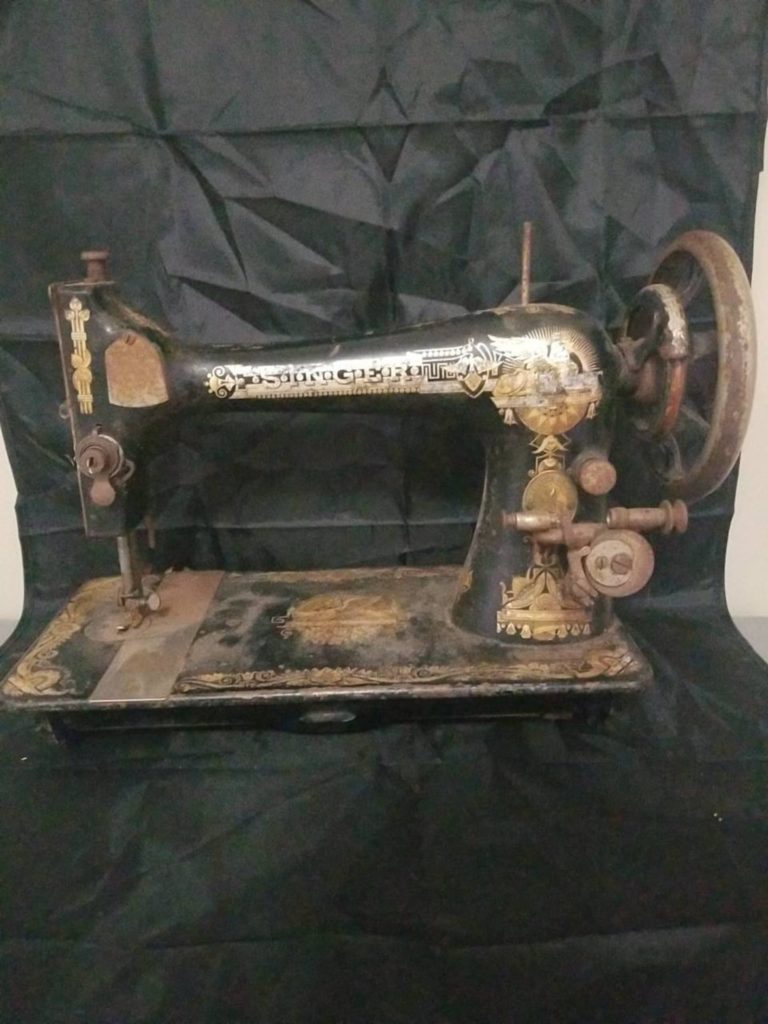
This is a very early Singer design, rarely seen on the antique market: Patent #BC2017, last patented in 1891. This machine is in a rather rusty state and most likely best used for display, unless you are really on the hunt for a project piece.
4. Standard Rotary
Year: 1880-1910
Color: Black & Gold
Features: Hand-Crank Rotary
Condition: Project
Price: $110
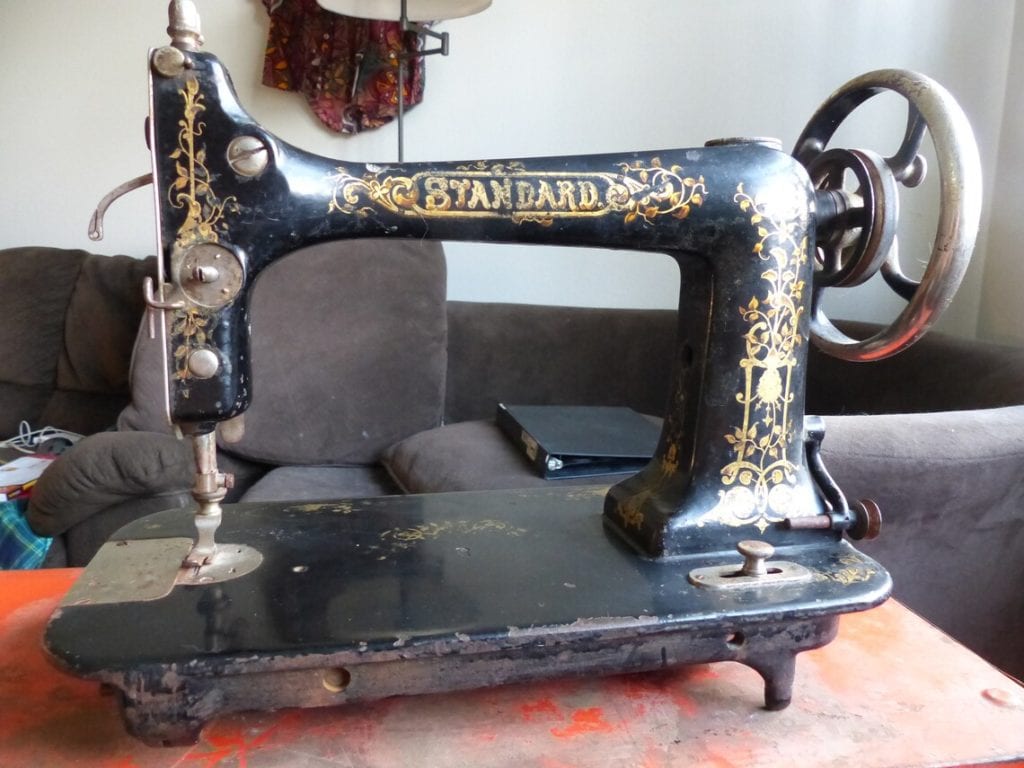
A beautiful old-fashioned sewing machine that is over a century old. This one is a “project piece”, meaning it will take some handiwork to get it functioning.
5. Opel Sewing Table
Year: 1896
Color: Black & Gold
Features: Foot-pedal
Condition: Functional
Price: $2078
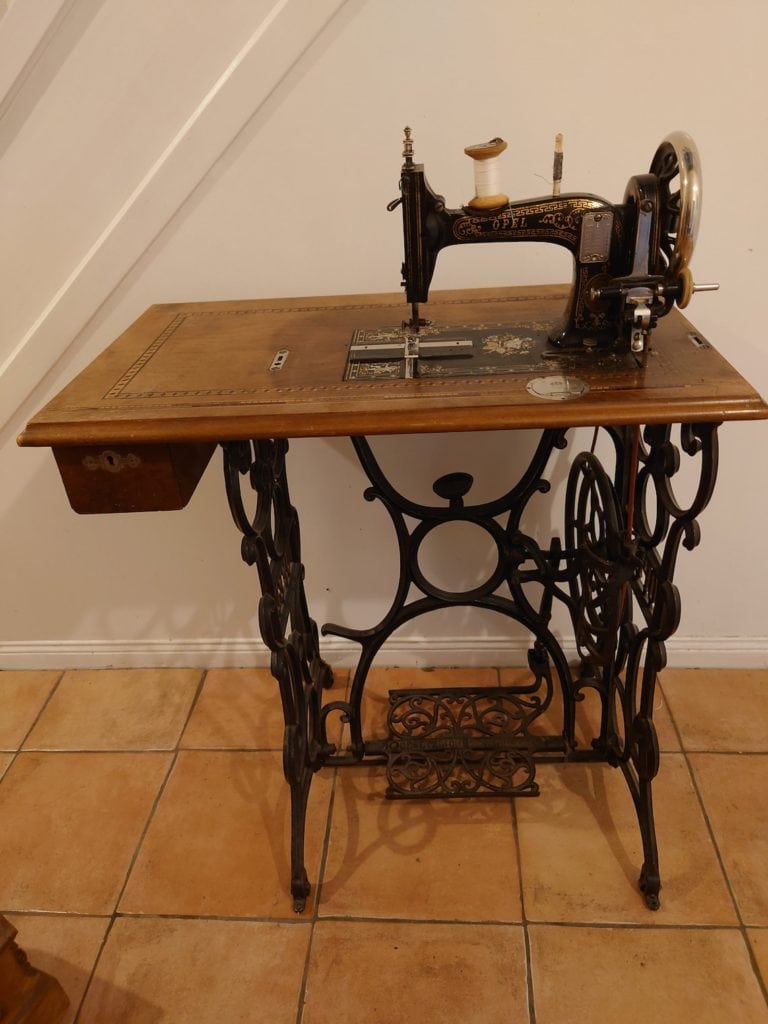
This sewing machine was a higher-end piece from the beginning as it comes integrated with a sewing table (the only integrated machine on this list). A machine cover and various sewing utensils are included as well.
6. Portable Singer
Year: 1920s
Color: Black & Gold
Features: Foot-pedal
Condition: Functional
Price: $287
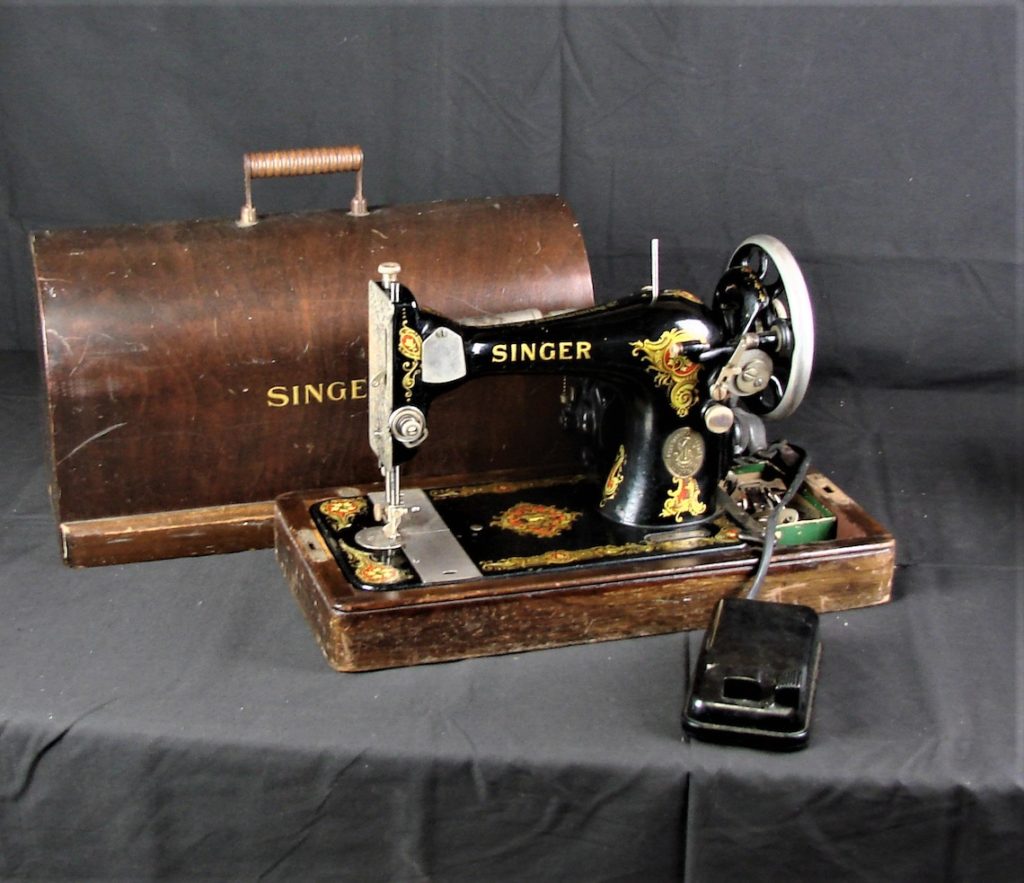
A portable sewing machine in excellent condition. The key for the case is included (a rarity), and while the seller recommends replacing the back belt and cord, the machine is technically functional.
7. Singer Model 15
Year: 1930s
Color: Black & Gold
Features: Electric
Condition: Project
Price: $250
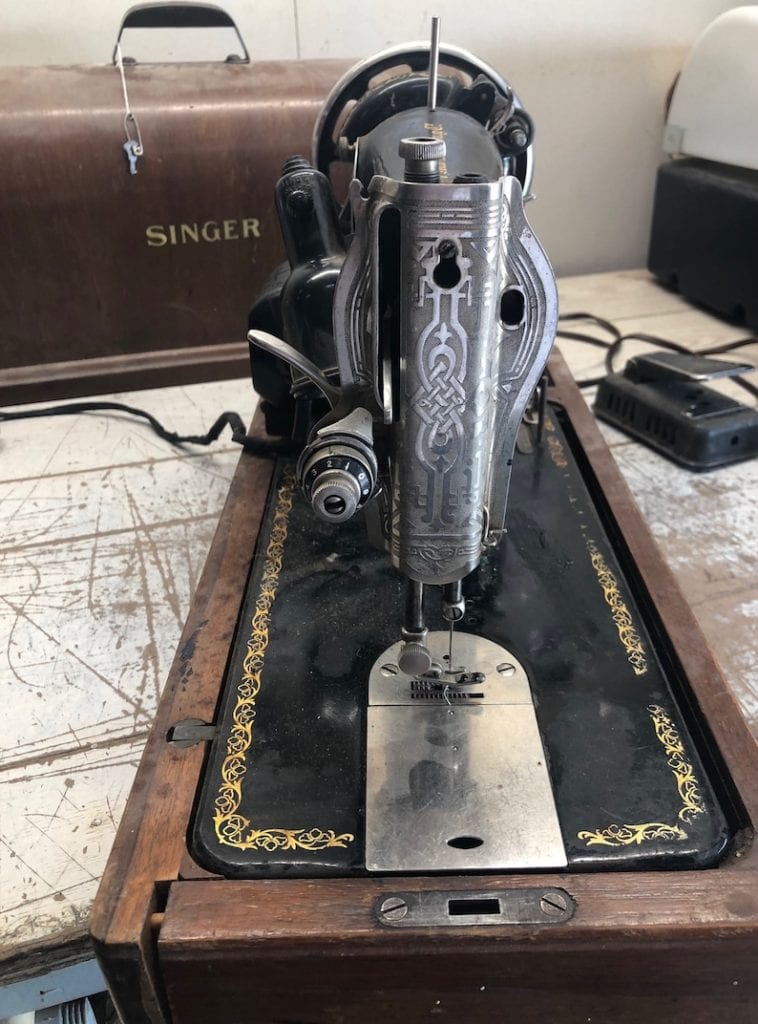
A portable machine with a light built-in, it runs but needs a good cleaning and most likely some fine-tuning. The power cord needs some patching or replacing as well, but once it’s fixed up it’ll be a doll!
II) 1940s Sewing Machines
1. Essex Miniature
Year: 1940s
Color: Red & Silver
Features: Hand-crank
Condition: Unknown
Price: $89
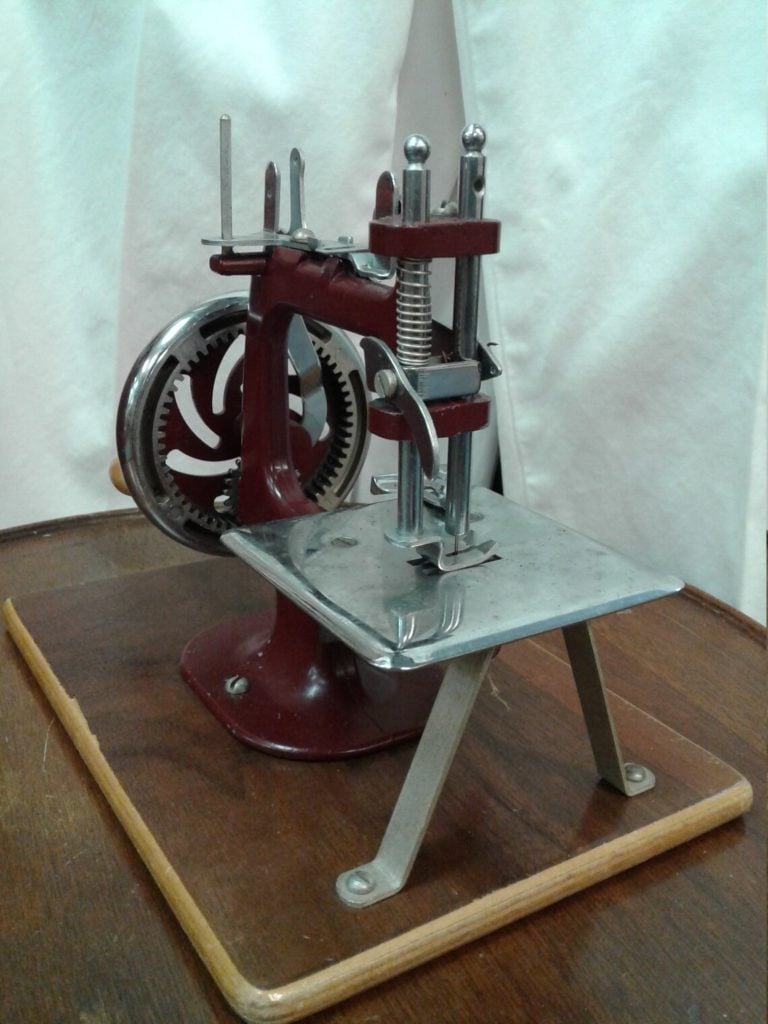
A departure from the gold-and-black scheme of prior years, this is the sleek post-WWI look. This machine has unknown functionality, so it may be a project or simply an unusual display piece.
2. Remington C-352
Year: 1940s
Color: Turquoise
Features: Electric
Condition: Functional
Price: $249
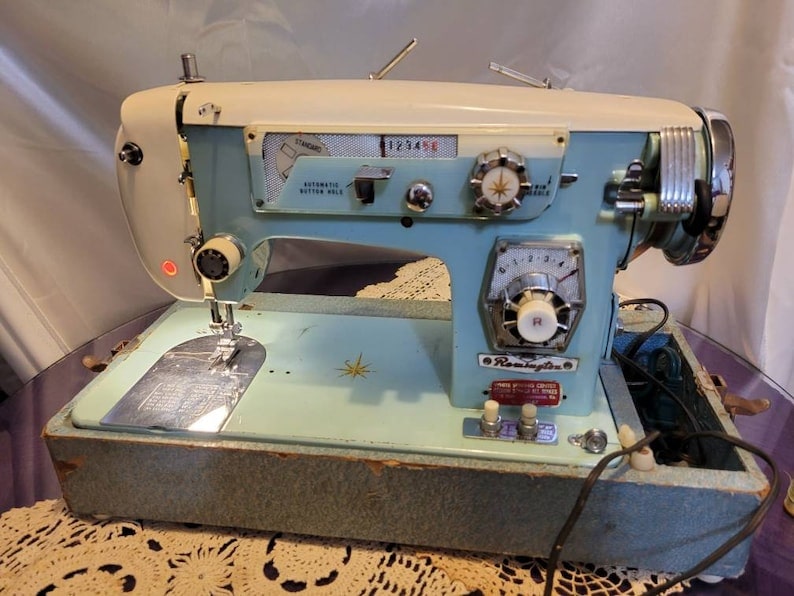
This is a classy machine with Streamline-Moderne influence showing in the casing design. (Chrome edging!) It runs smoothly, and all the accessories are accounted for.
3. Junior Miss Machine
Year: 1940s
Color: Red & Silver
Features: Hand-crank
Condition: Incomplete
Price: $75
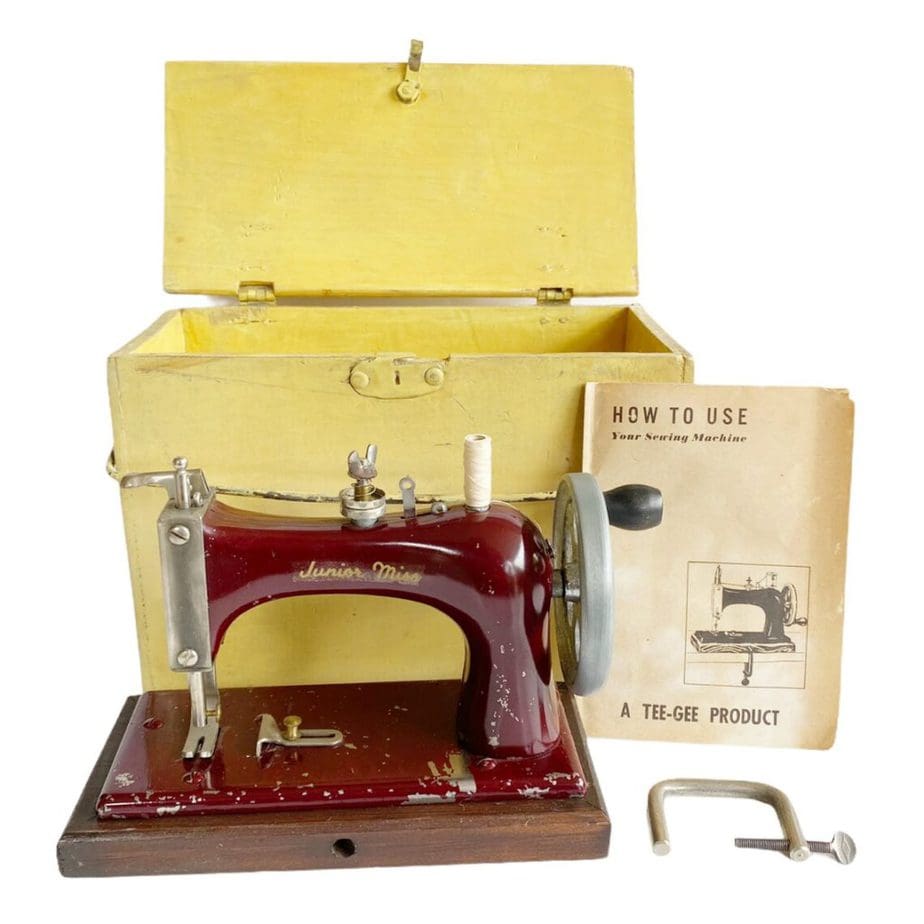
This piece is a miniature sewing machine designed for a child to play and/or learn on. It is missing a needle, it’s otherwise indeterminate if the machine is functional.
III) 1950s Sewing Machines
1. Jones Model D53a
Year: 1953
Color: Black & Gold
Features: Hand-crank
Condition: Functional
Price: $366
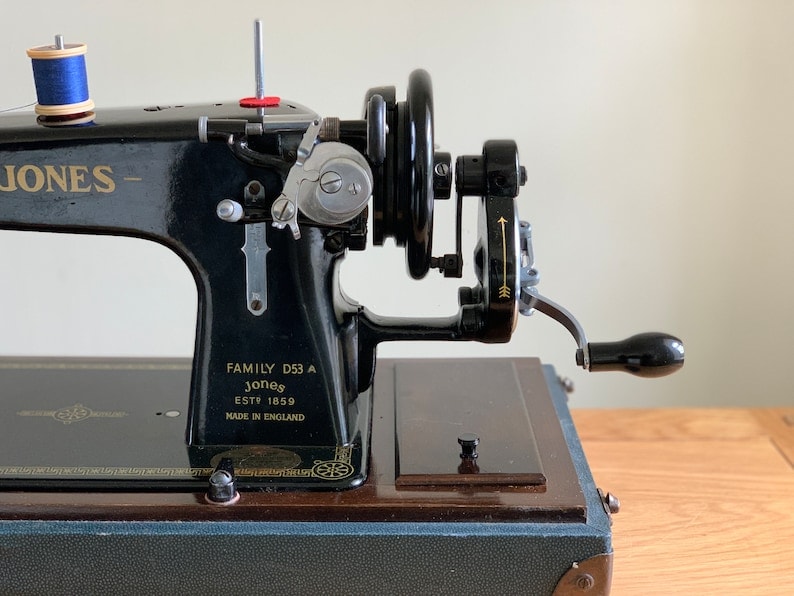
Jones Brand was founded in 1859, so this is a near-centennial model—perhaps that’s why the throwback design of black and gold. The pictures suggest functionality, and a small pocket contains accessories, including original bobbins.
2. Portable Soviet “Tula” Machine
Year: 1958
Color: Mint
Features: Hand-crank
Condition: Unknown
Price: $210
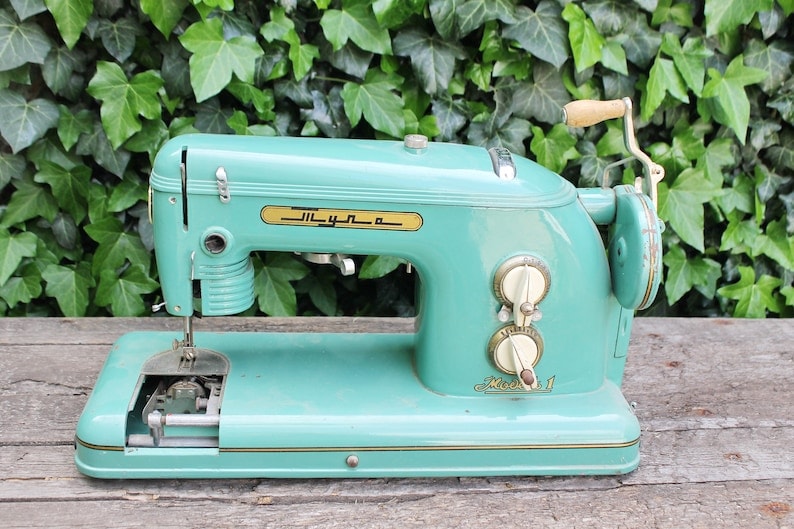
Another Streamline-Moderne design, this time from the USSR. The machine seems like it should be operational, but there aren’t many details on the listing. There is no needle included, so that at least would have to be sorted out!
3. Singer 404
Year: 1959
Color: Beige
Features: Electric
Condition: Incomplete
Price: $64
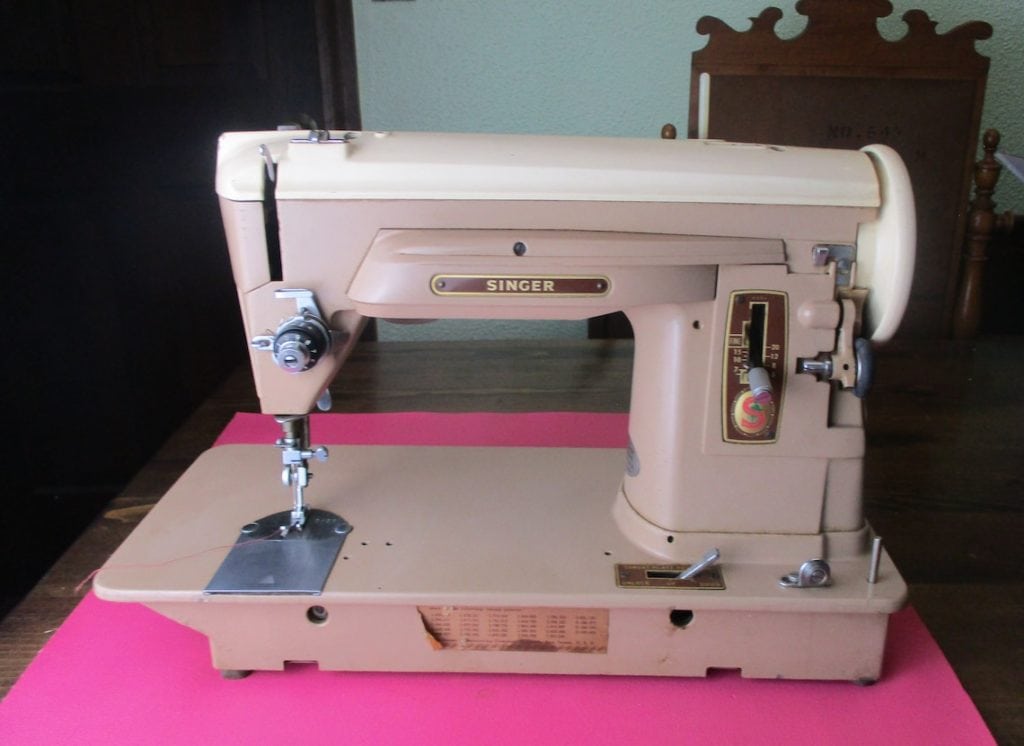
This is a classic Singer 404, one of their best-known models. It needs a detailed cleaning and oiling; the foot pedal is not included.
4. Singer 66-16
Year: 1950s
Color: Black & Gold
Features: Electric
Condition: Project
Price: $200
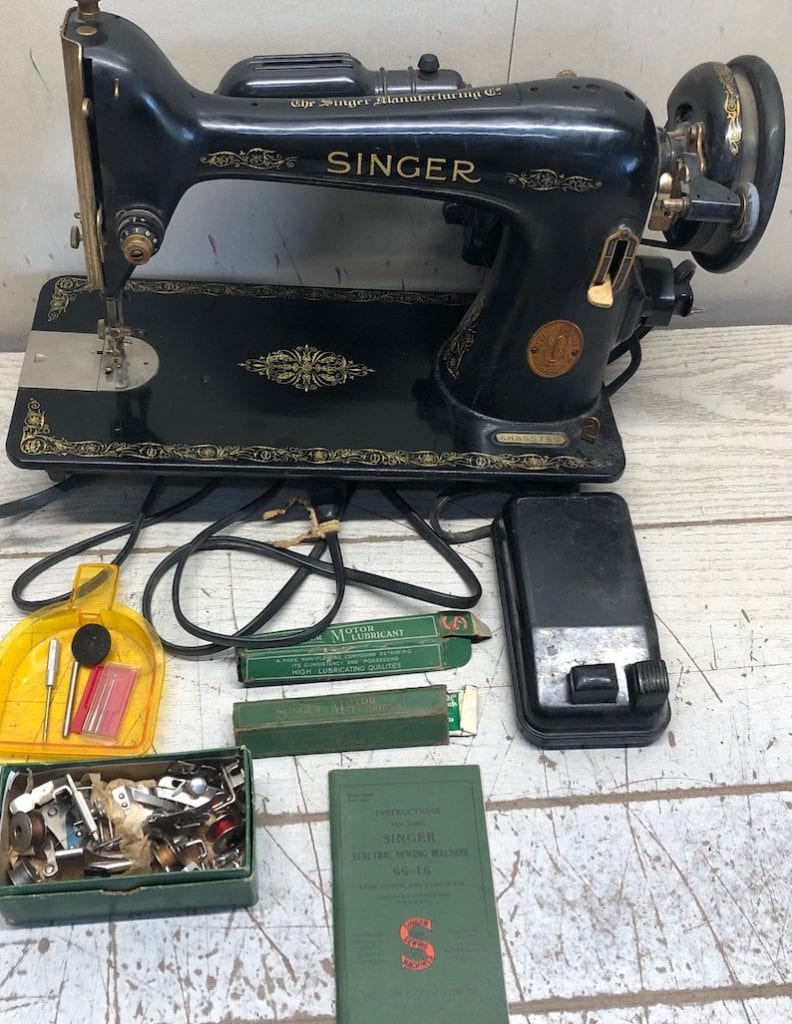
Here’s a throwback to the original design of Singer machines. This machine is oiled and lubricated but requires some fine-tuning to run smoothly. It comes with an extra manual as well.
5. Vulcan Machines
Year: 1950s
Color: Red, Tan, or Black
Features: Hand-crank
Condition: Varies
Price: $40
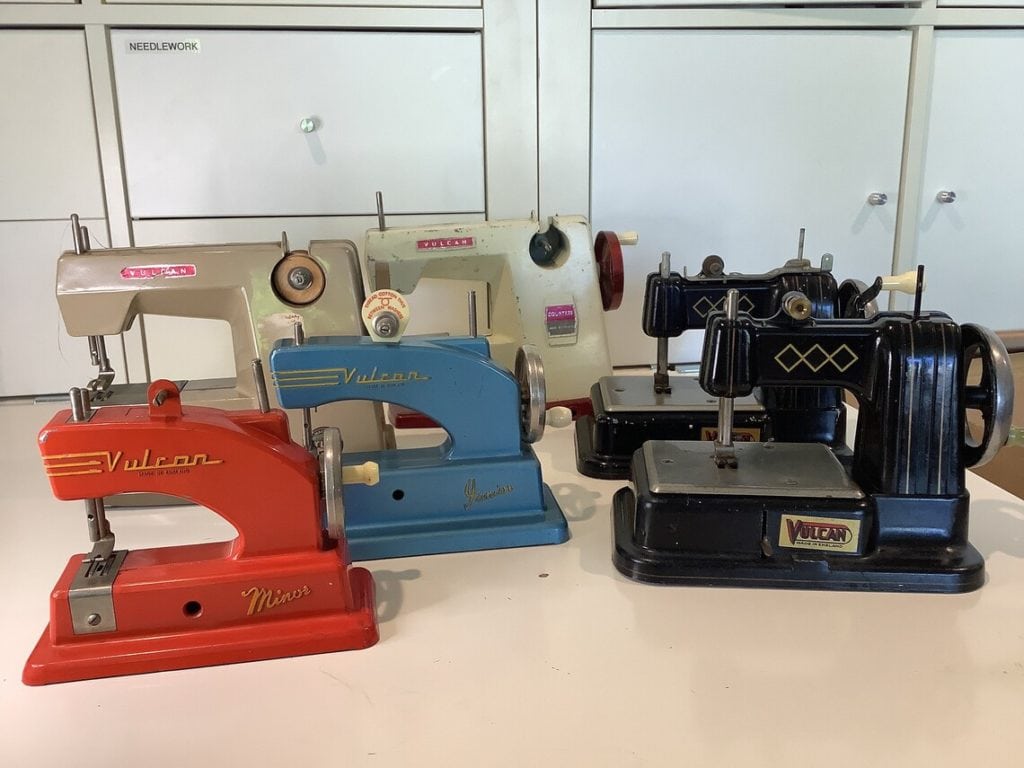
This listing has several options at $40 each running the gambit of the Vulcan models during the 1950s, from Minor models to Countess and Rare models. They vary in functionality.
6. Singer 301a
Year: 1950s
Color: Golden
Features: Electric
Condition: Functional
Price: $195
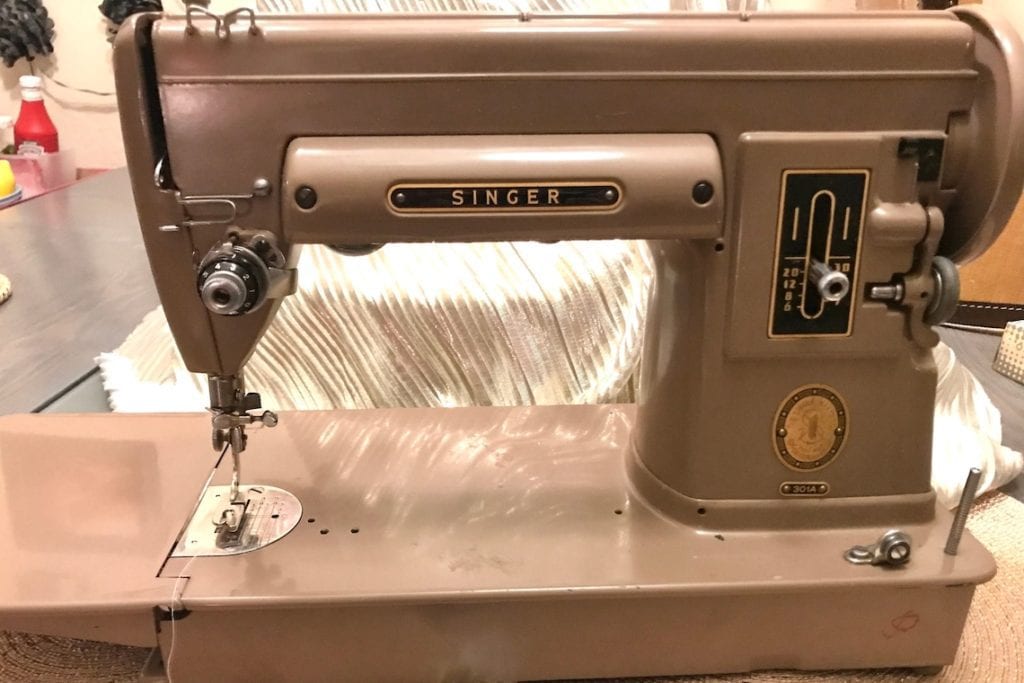
This machine has been well-cared for. It is fully functional, still with the original box and instructions. There is a zipper foot as well.
7. Brother Cavalier Machine
Year: 1950s
Color: Brown & White
Features: Electric
Condition: Functional
Price: $200
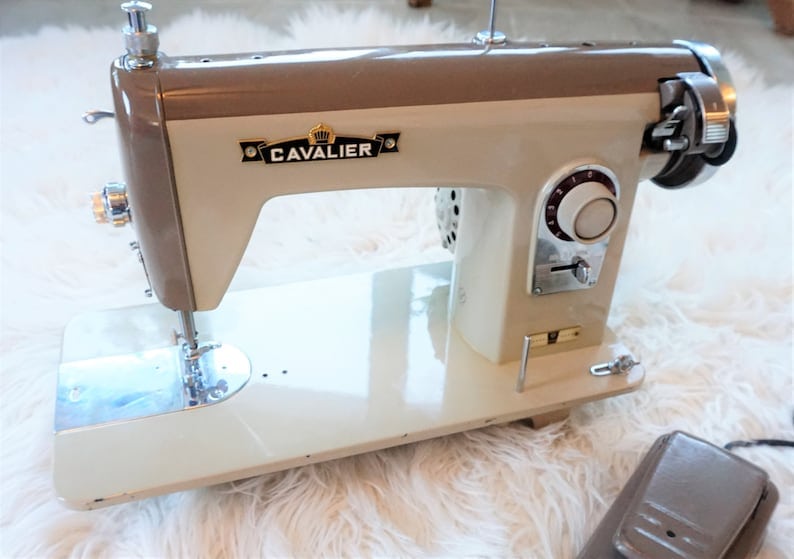
A Cavalier brand sewing machine produced by Brother, this piece is lacking some information but seems to be in working condition.
8. DressMaker 290
Year: 1950s
Color: Baby Blue
Features: Electric
Condition: Functional
Price: $200
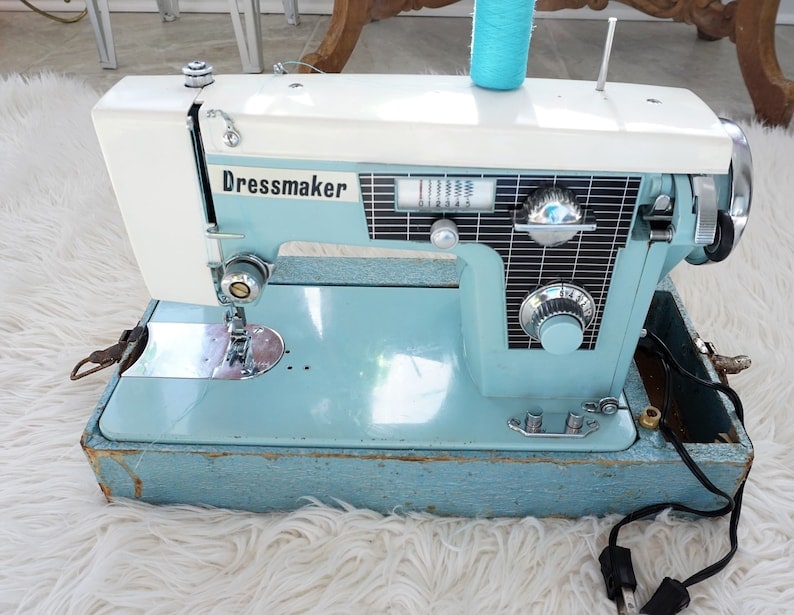
This machine has been serviced and cleaned prior to listing. The casing has signs of age, of course, but the machinery is ready to function perfectly.
IV) 1960s Sewing Machines
1. White 65
Year: 1960s
Color: White
Features: Electric
Condition: Functional
Price: $500
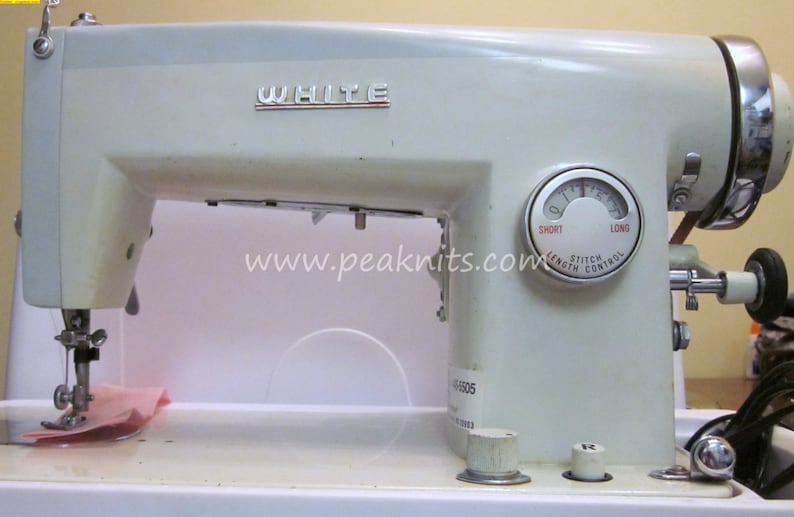
This White brand machine was made by Husqvarna Viking. The machine is fully functional, it comes with the original foot pedal but a new carrying case.
2. Singer 620 Touch-and-Sew
Year: 1960s
Color: White & Gold
Features: Electric
Condition: Functional
Price: $225
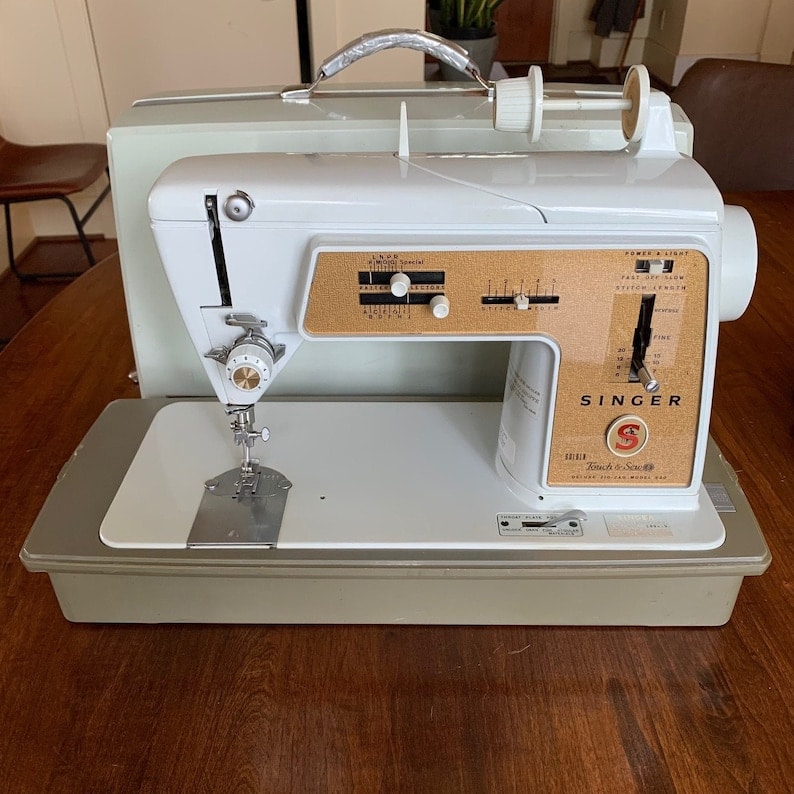
This machine comes with the original case, cams, and twelve bobbins. It has been serviced and tested, but shows some surface wear (and duct tape, on the case).
3. Hungarian Csepel 30
Year: 1960s
Color: Black & Gold
Features: Hand-crank
Condition: Functional
Price: $234
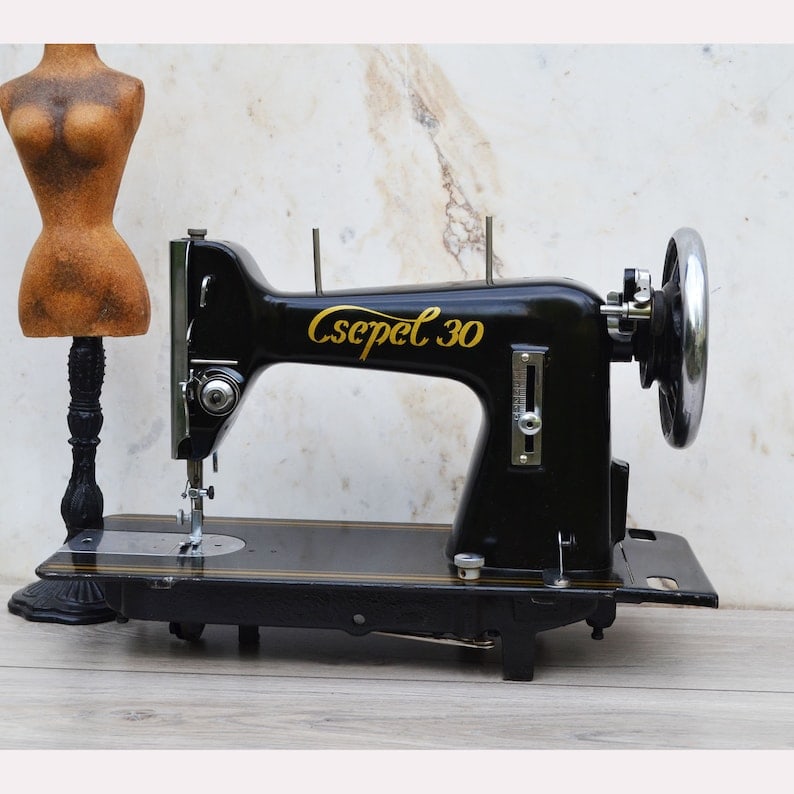
This is the only Hungarian sewing machine encountered, so a unique piece of sewing history! It is mechanically functional.
4. Singer Style-Mate 347
Year: 1960s
Color: Robin-egg Blue
Features: Electric
Condition: Functional
Price: $165
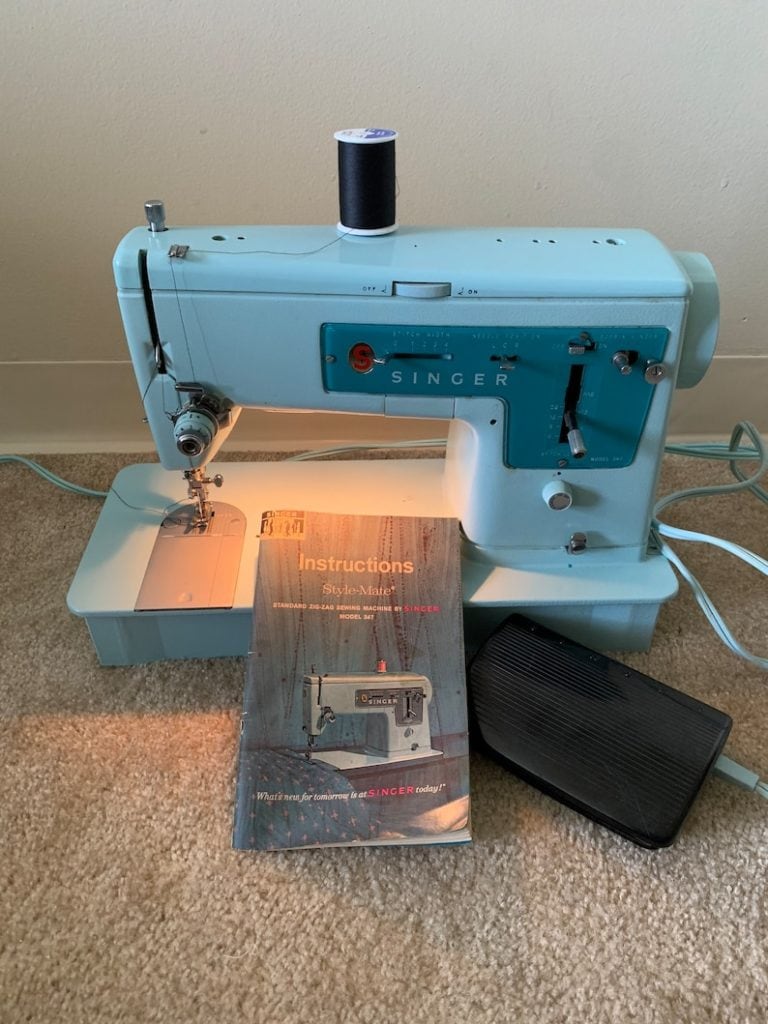
This is an unusually colored sewing machine; Singer went bright through this era (in certain models). This machine seems to be fully functional, it includes the manual and accessories, like extra needles and bobbins.
5. Singer Style-O-Matic 328K
Year: 1960s
Color: Grey & Gold
Features: Electric
Condition: Functional
Price: $200
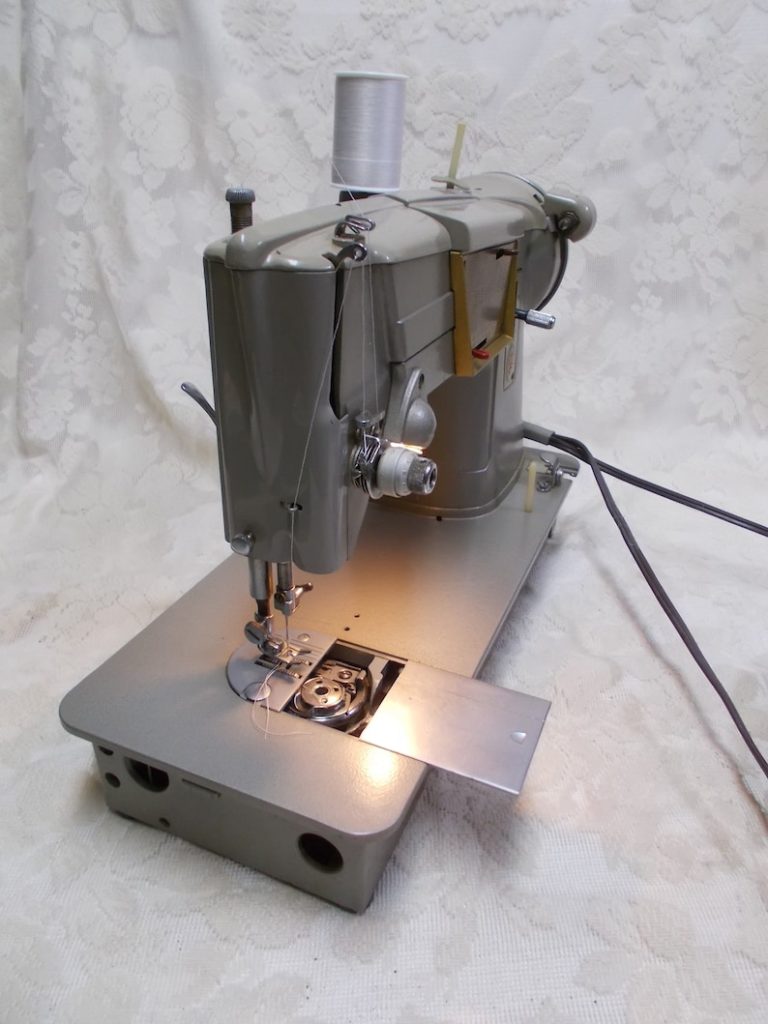
Straightforward and easy to use, this style-o-matic (groovy model name!) is ready to sew. It comes replete with attachments, cams, and a manual.
V) 1970 & 80s Sewing Machines
1. Kenmore Sears 158
Year: 1970s
Color: Off-white
Features: Electric
Condition: Functional
Price: $225
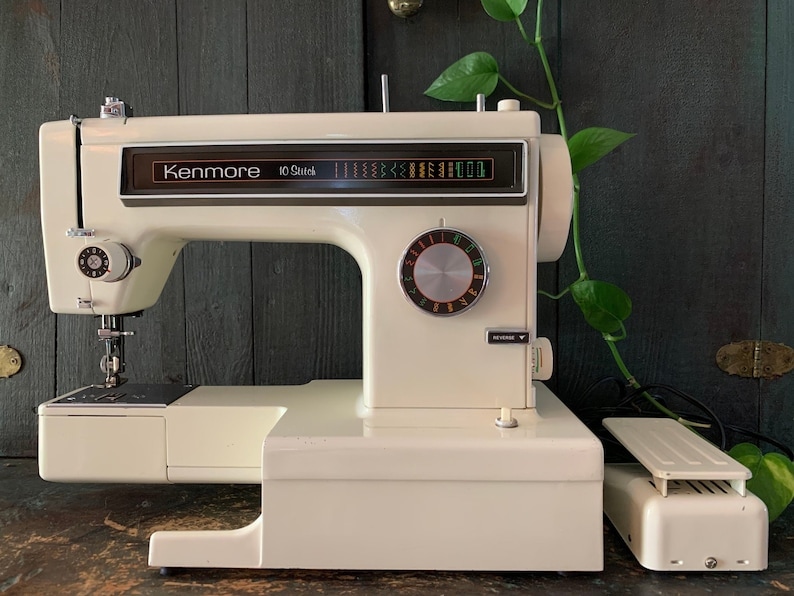
This model was popular for the wide range of sewing it could handle, from industrial-weight weaves to fine fabrics. It works well, the only thing missing is the extension table—even the manual is accounted for!
2. Wizard Machine
Year: 1970s
Color: Turquoise
Features: Electric
Condition: Functional
Price: $145
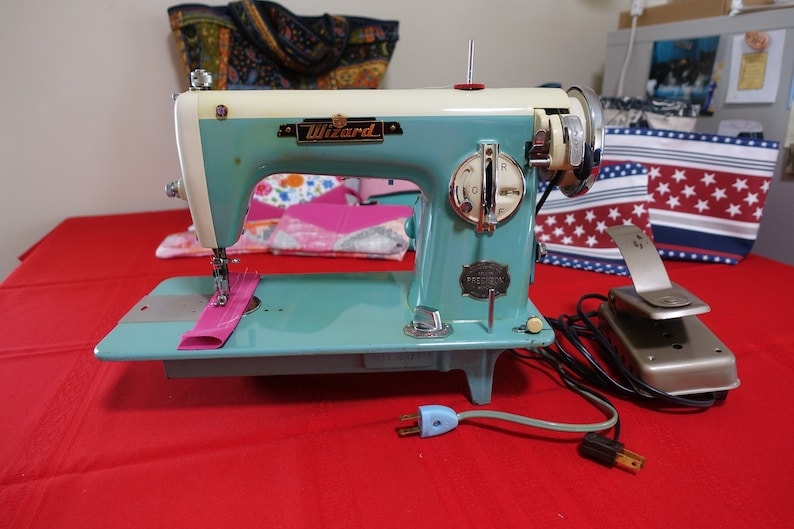
Wizard was a unusual brand—their machines were all produced by major brands and simply branded by Wizard. For sewing machines, their manufacturer was Brother. This machine appears to be nearly identical to a Brother Coronado 1350.
3. Singer Style-O-Matic 328K #2
Year: 1970s
Color: Grey & Gold
Features: Electric
Condition: Functional
Price: $65
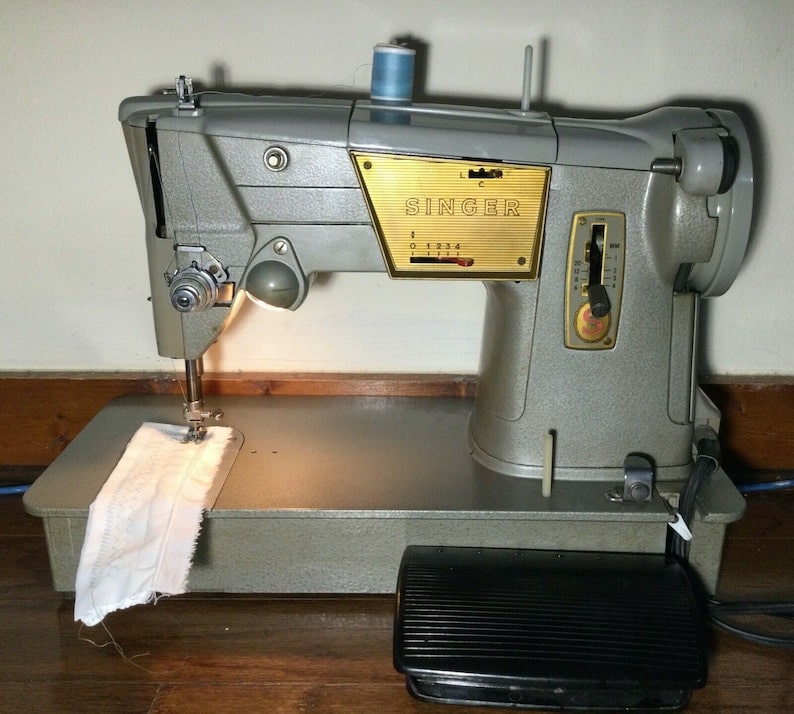
For straightforward use, this machine only has two options (width and length) to control the stitch. It is in working condition, with minimal evidence of wear.
4. Kenmore Sears Roebuck
Year: 1970s
Color: Off-white
Features: Electric
Condition: Functional
Price: $180
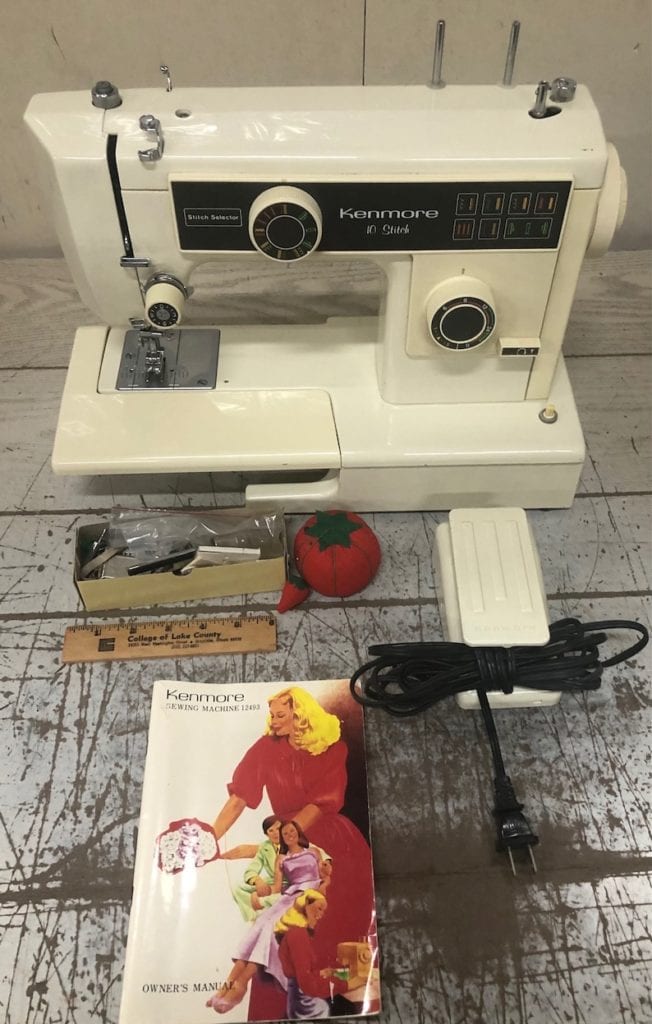
With 10 stitch settings and plenty of accessories (from mini screwdrivers to a 6” ruler), this machine will have you up and running in no time.
5. Brother VX-1120
Year: 1980s
Color: Off-white
Features: Electric
Condition: Functional
Price: $140
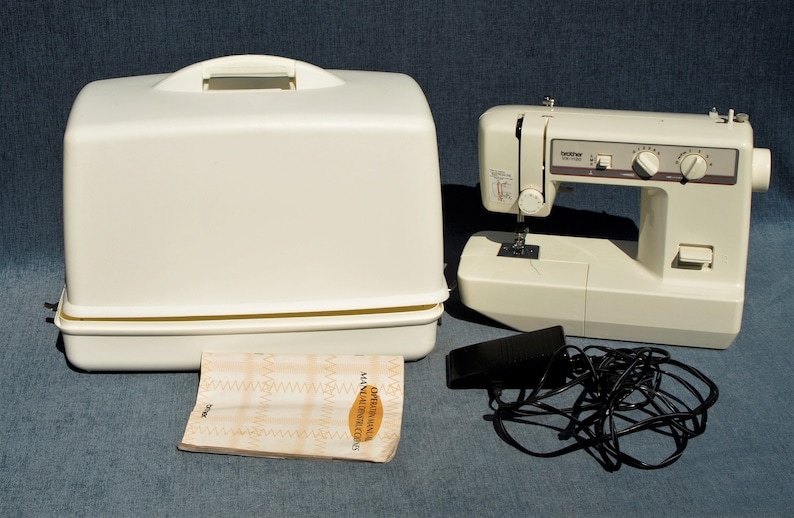
Nearly new condition and sews like it, this machine is right on the edge of vintage. It’s a catch for an older machine that nonetheless features a variety of sewing options.
VI) Late 20th Century Sewing Machines
1. Toy Singer
Year: 1950s
Color: Tan
Features: Hand-crank
Condition: Functional
Price: $128
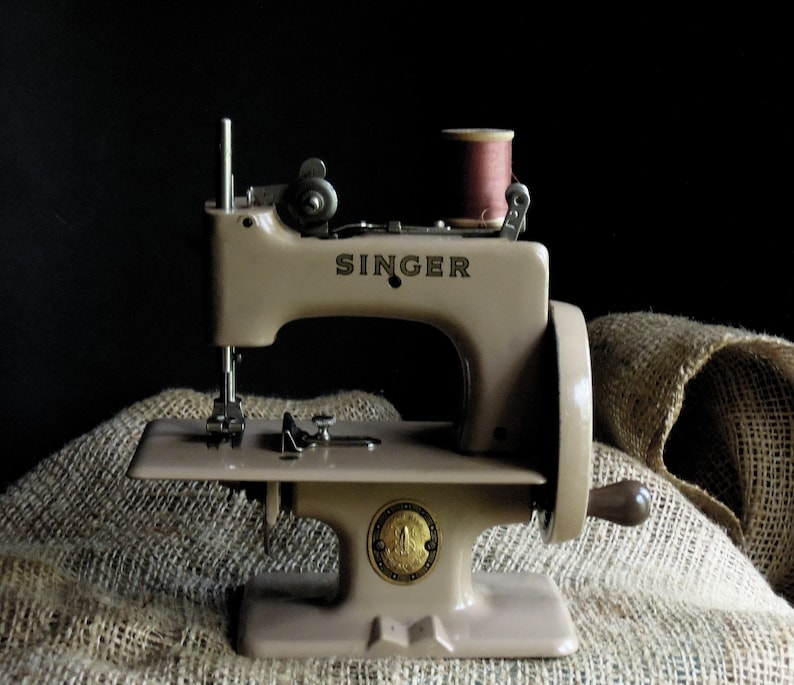
This is a small toy-sized machine that is nonetheless fully functional for all your basic sewing needs. This machine has the original needle and a vintage spool of thread included.
2. Soviet Toy
Year: 1960s
Color: Red
Features: Hand-crank
Condition: Project
Price: $35
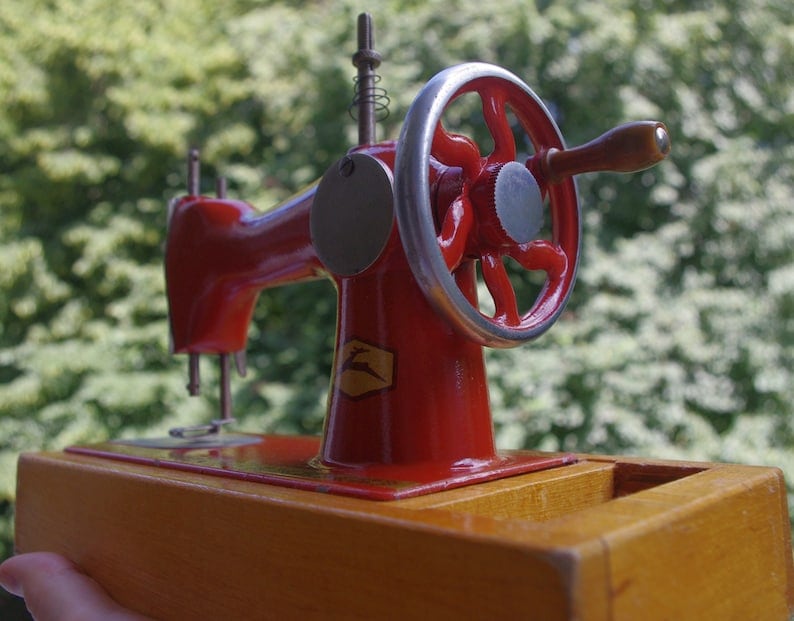
Most antique machines are manufactured in America, Europe, or Japan—this is an outlier from a Soviet production. The needle is missing, the machinery needs some fine-tuning, but the wheel operates the mechanism just fine.
3. Kayanee Sew Master
Year: 1960s
Color: Red
Features: Hand-crank
Condition: Unknown
Price: $39
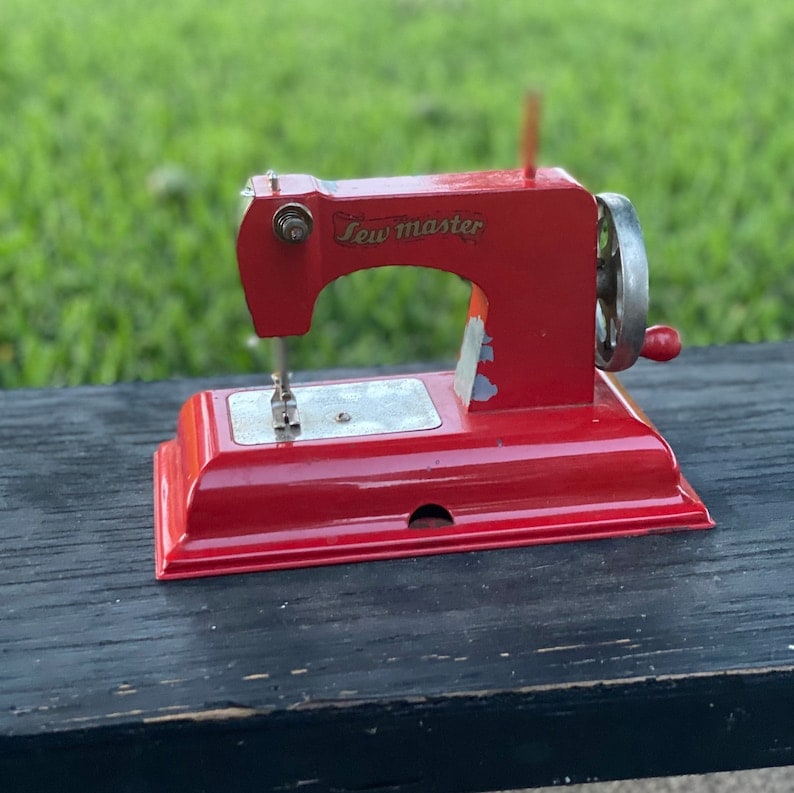
This machine has seen some love and play, with more surface paint-chipping visible on it. The conditions of the mechanical pieces are unclear from the description.
4. Tin Sewmate
Year: 1970s
Color: Yellow
Features: Hand-crank
Condition: Unknown
Price: $89
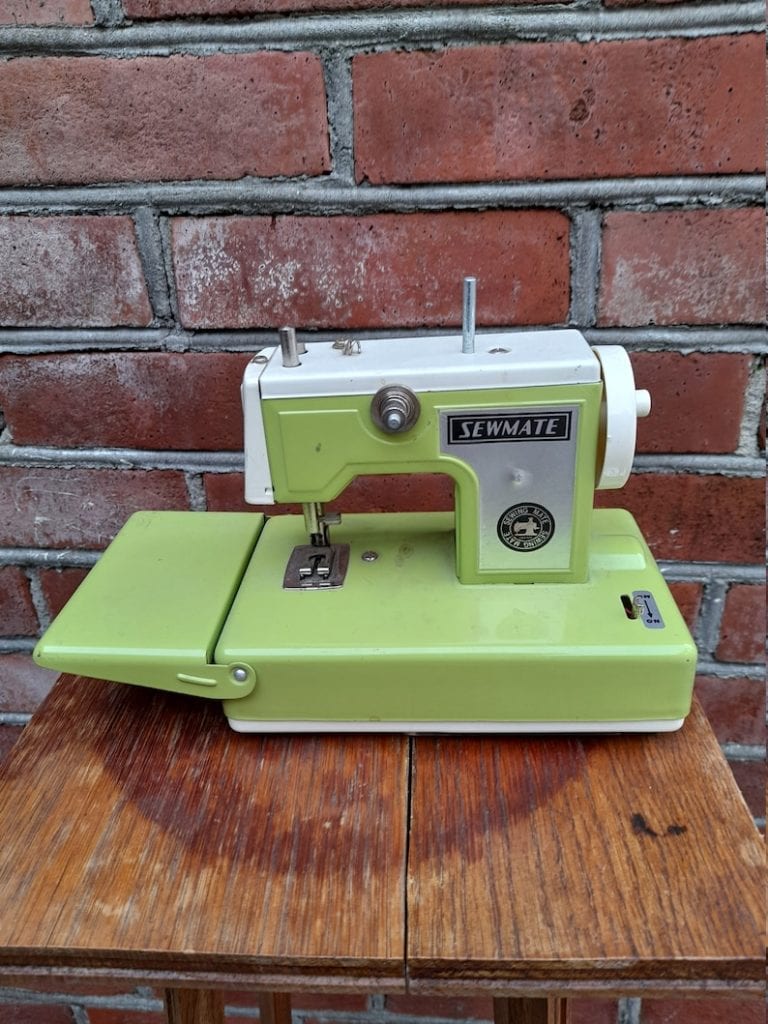
The global marketplace takes hold with this machine, as it has a Japanese origin. Collectable as an antique tin toy, it is unclear what the state of the sewing mechanism itself is.
5. Singer Reproduction Toy
Year: 1970s
Color: Black & Gold
Features: Hand-crank or Battery
Condition: Functional
Price: $50
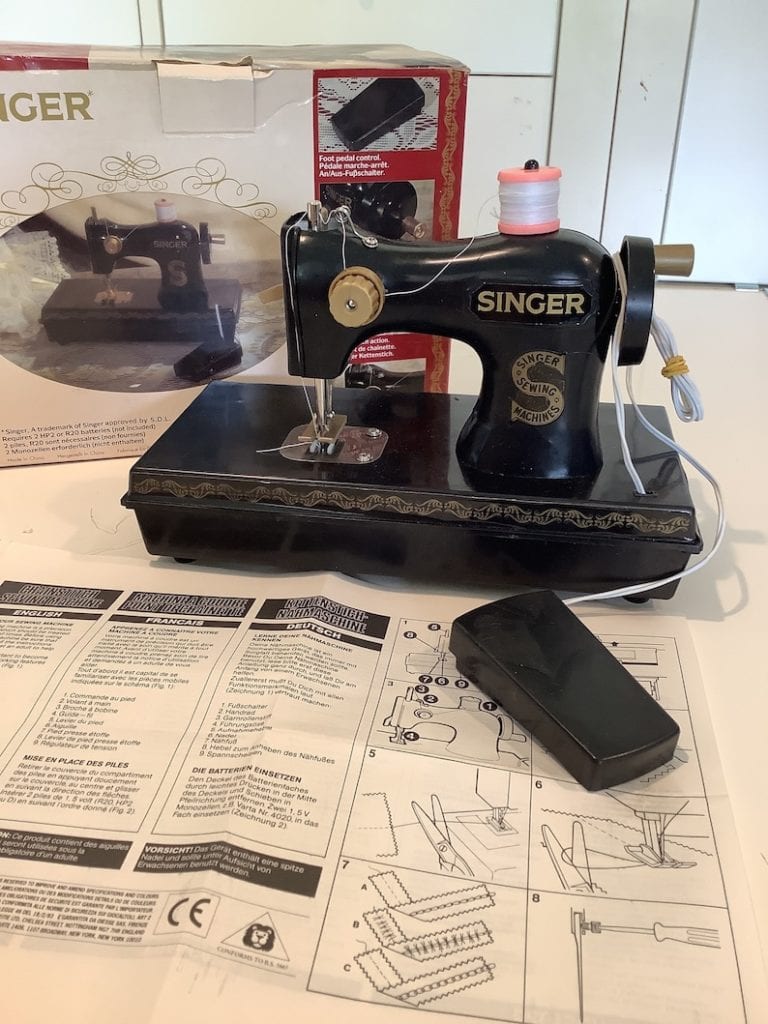
While this machine is dated to the 1970s by the included box and instructions, the design of the machine replicates the early sewing machines’ style from the late 19th-century. This machine appears to be new or nearly new.
6. French Singer 67b
Year: 1970s
Color: White & Red
Features: Battery
Condition: Unknown
Price: $149
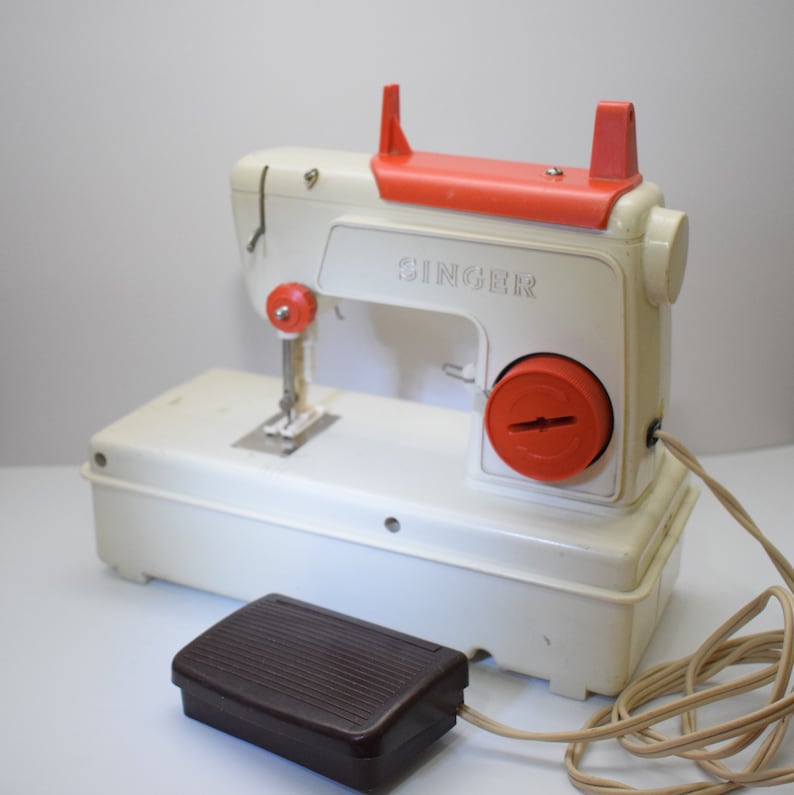
Battery operated: this is the only toy sewing machine on this list to not have a hand-crank. The motor runs on this machine, but as there is no bobbin or bobbin case, it is unknown if the machinery is functional.
VII) Antique Singer Sewing Machines
1. Model 99-13, Class 66
Year: 1925
Color: Black & Gold
Features: Electric
Condition: Incomplete
Price: $200
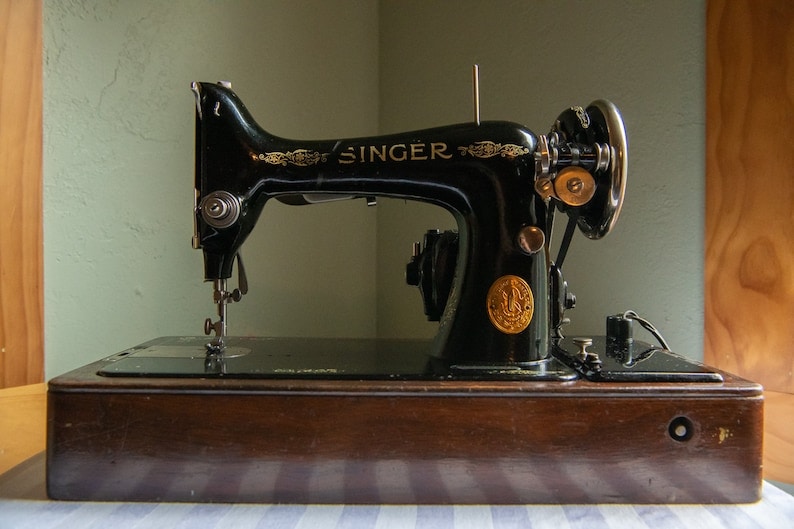
This Singer model-class is notable for the ease of maintenance. The motor and belt are both easy to access to fix and/or replace, making this an easy machine to keep up over the years. This machine is a project as it is missing the knee-lever, although everything else seems functional.
2. Model 201-2
Year: 1938
Color: Black & Gold
Features: Electric
Condition: Functional
Price: $565
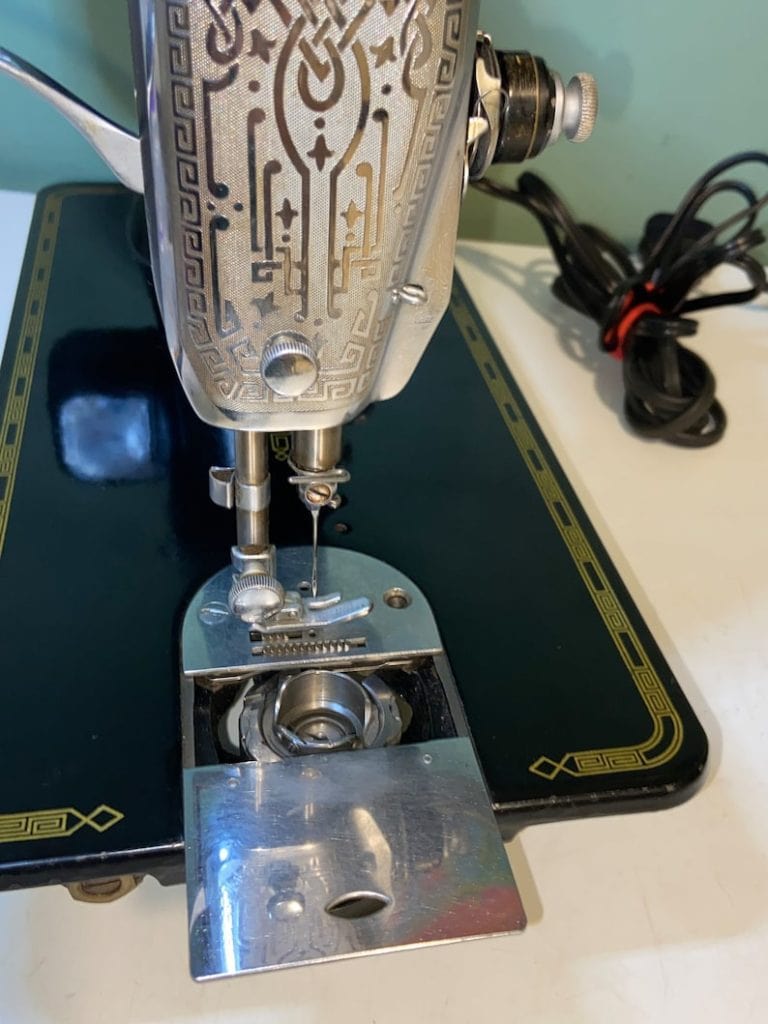
The Singer 201 series is renown for their power & speed—still. There were three variants, this one is the gear-powered one. This machine has been serviced, ready to go!
3. Model 15-91
Year: 1940s
Color: Black & Gold
Features: Electric
Condition: Functional
Price: $330
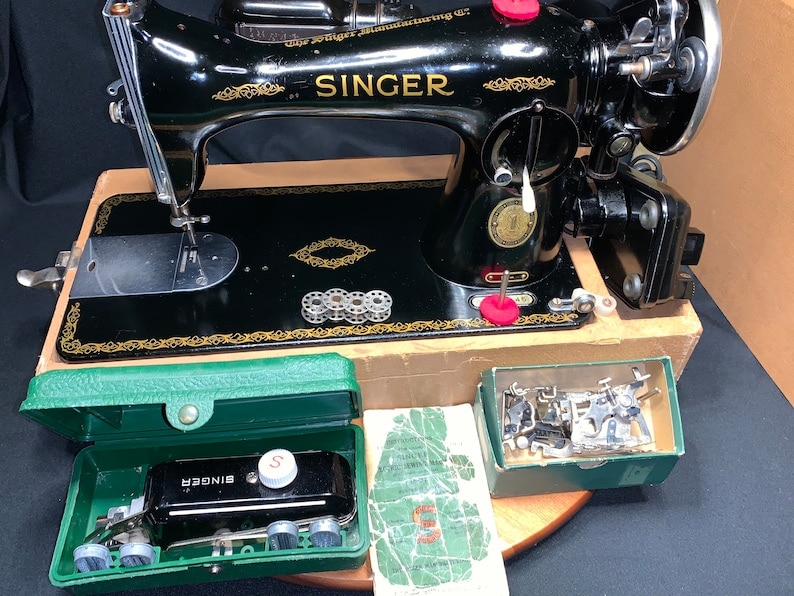
The 15-91 is another good Singer model for ongoing longevity. The motor is a bit harder to access than the 99/66 but the machine is gear-driven so it is relatively straightforward to find replacement pieces as needed. This machine has already been rewired and serviced, so it is ready to use. It comes with extra attachments and bobbins, as well as the original manual.
4. Featherweight 221K Model #1
Year: 1951
Color: Black & Gold
Features: Electric
Condition: Functional
Price: $699
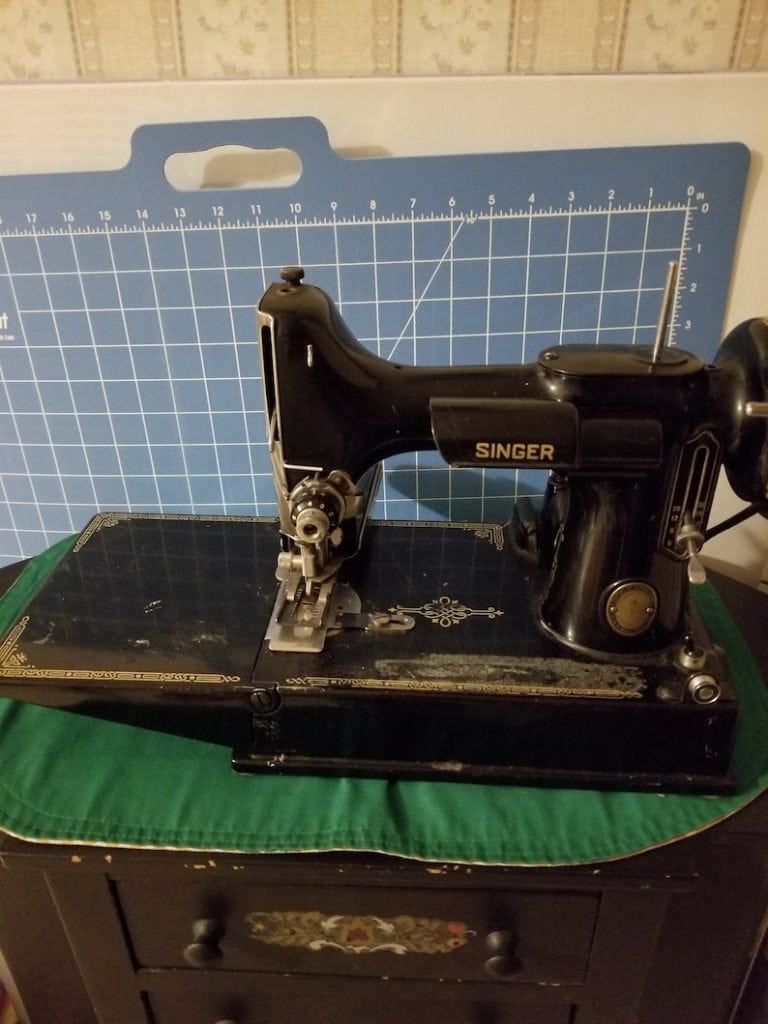
This version of the Featherweight 221K was released by Singer for their centennial in 1951. It is a retro design that came in a heavy-duty carrying case. This listing includes extra accessories and bobbins as well.
5. Featherweight 221K Model #2
Year: 1951
Color: Black & Gold
Features: Electric
Condition: Functional
Price: $648
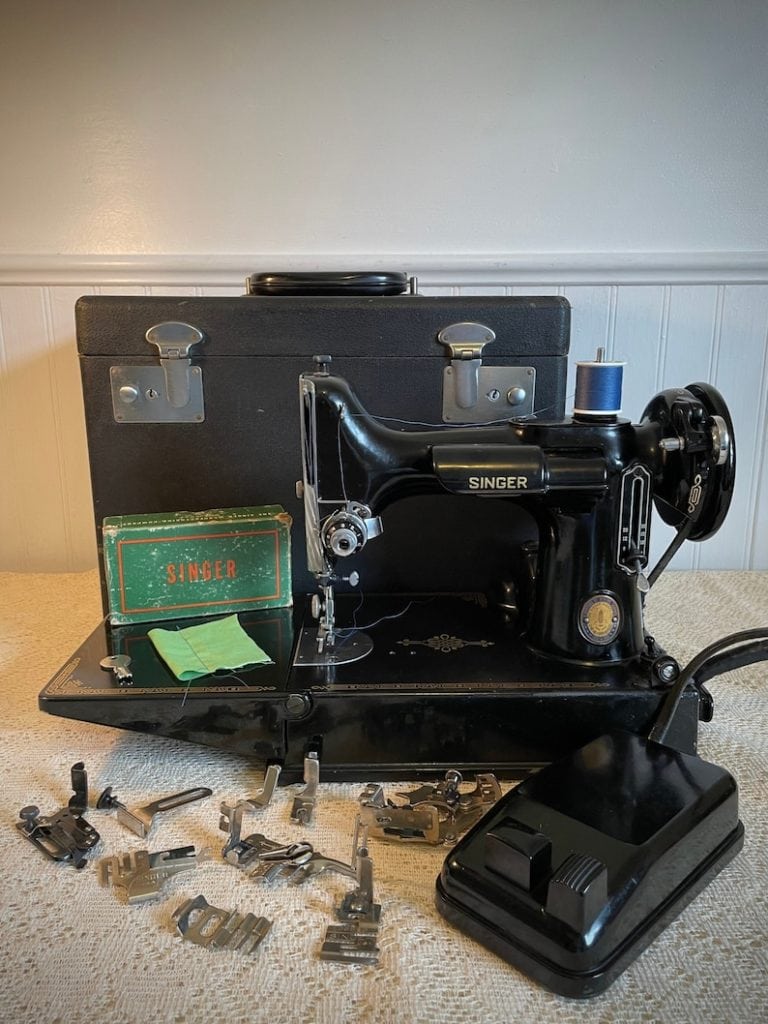
Another listing for a Featherweight, also in excellent condition and including extra accessories and bobbins.
6. Featherweight 221K Model #3, in White
Year: 1960s
Color: White
Features: Electric
Condition: Functional
Price: $715
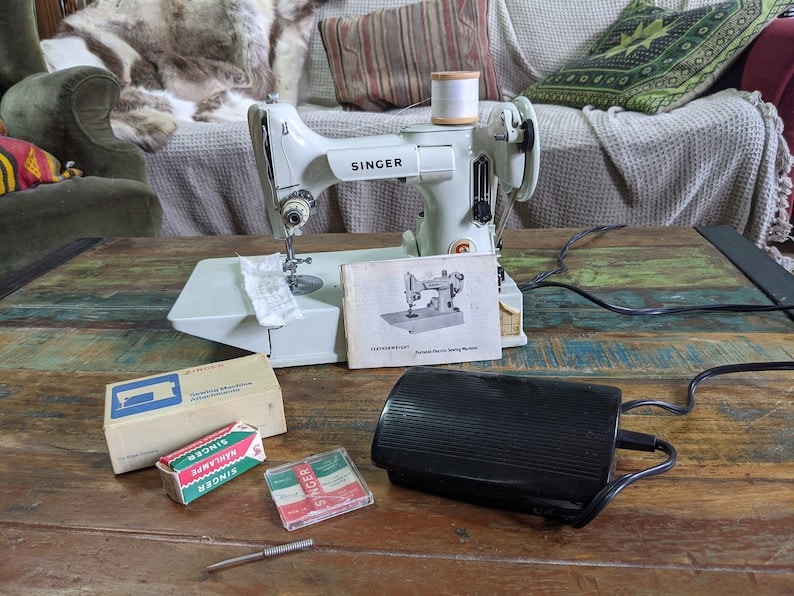
Singer continued producing Featherweights into the ‘60s when they manufactured this white version. This machine also comes with a manual and accessories, including bobbins.
VIII) Antique Zig-zag Sewing Machines
1. Singer 403 Machine
Year: 1950s
Color: Tan
Features: Electric
Condition: Functional
Price: $345
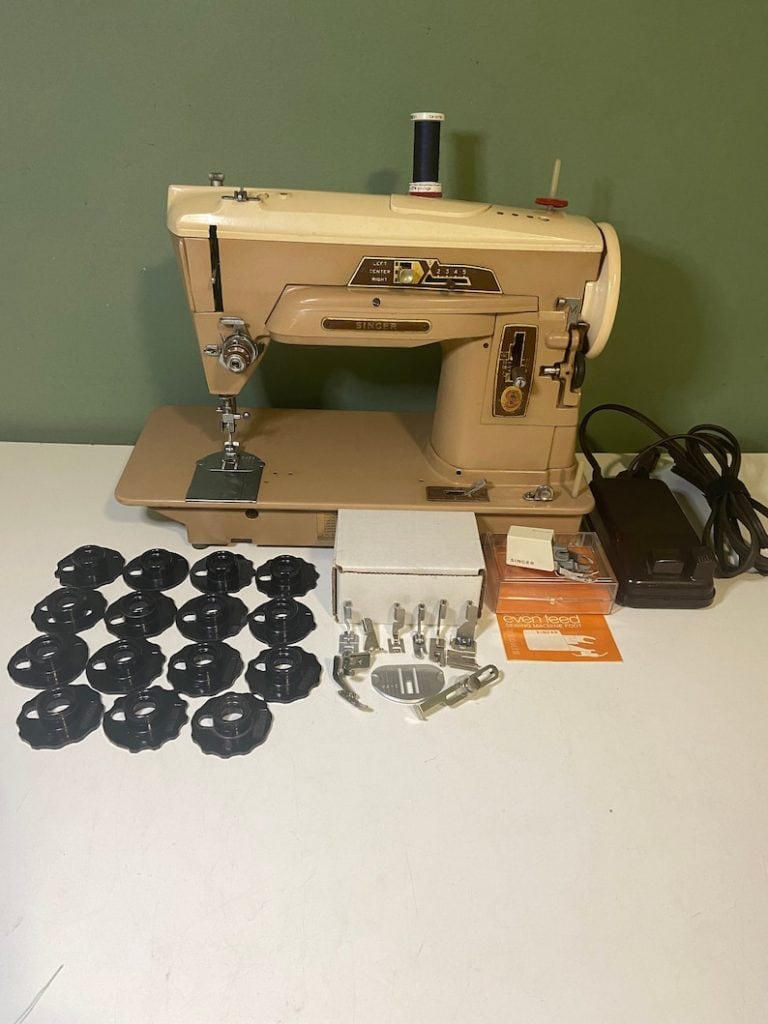
This machine is in excellent functional condition, as the seller has had it fully serviced prior to listing. Along with the machine head, there are several cams and foot attachments included in the price.
2. Idle Hour Pink Machine
Year: 1950s
Color: Pink
Features: Electric
Condition: Unknown
Price: $450
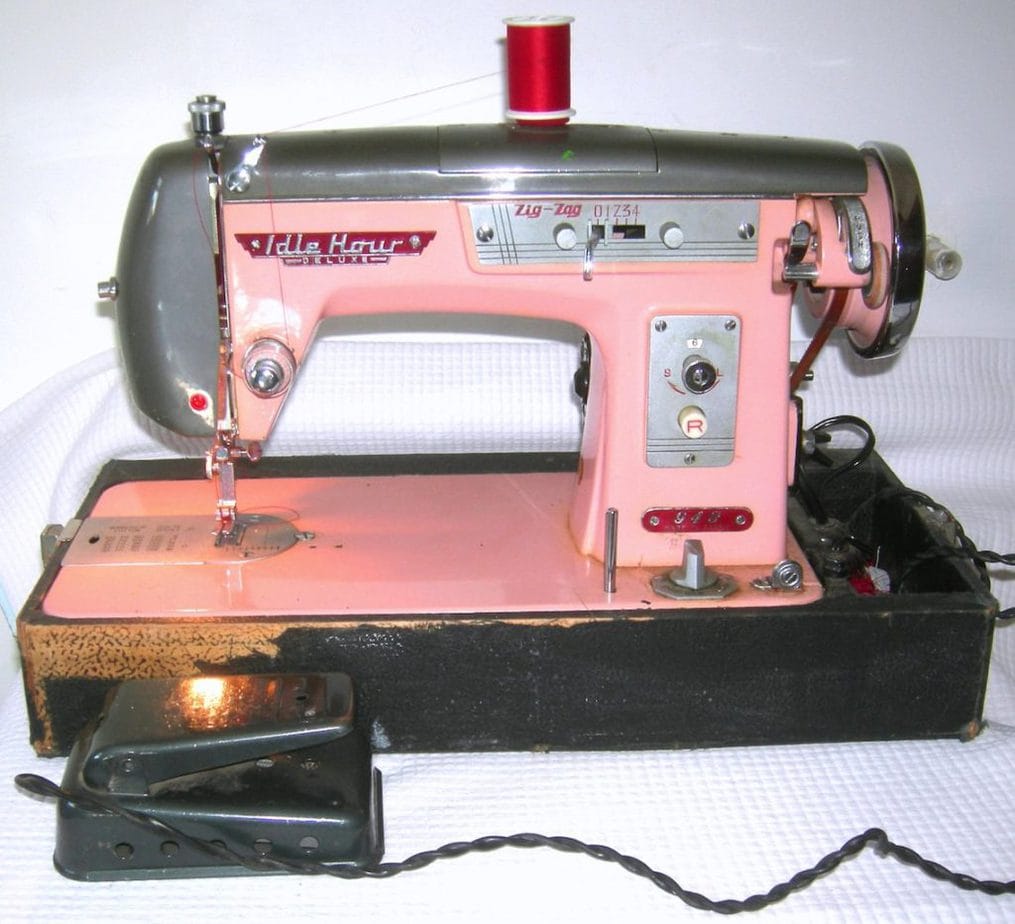
This is a rare brand, with only one other listing surfacing in a brand-specific search. It is a Japanese make & a unique color, but there is no verification of its functionality offered by the seller.
3. Nelco Hallmark
Year: 1960s
Color: Light Blue
Features: Electric
Condition: Functional
Price: $400
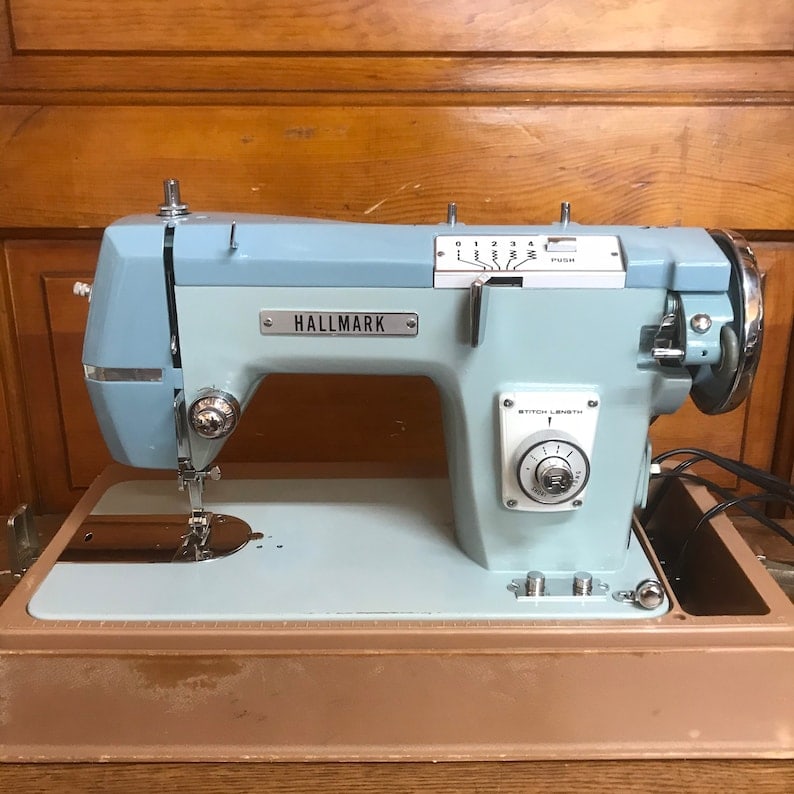
Nelco is a Japanese brand, known in their market for high-quality machines. This machine has been restored to full functionality, with the tensions and timings reset to be on-point.
4. Singer 630 Machine
Year: 1960s
Color: White & Brown
Features: Electric
Condition: Functional
Price: $115
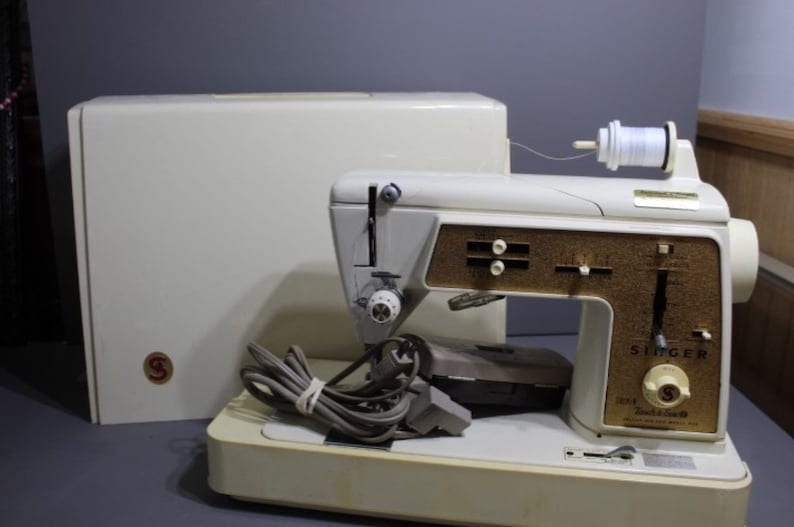
With pattern selection, stitch width & length, and even a buttonhole option, this sewing machine features all the controls you’re most likely to need for your sewing. The pedal, cord, and case are all included as well so the machine head is fully operational.
5. Sears Kenmore Model 148.13000
Year: 1960s
Color: White & Blue
Features: Electric
Condition: Functional
Price: $450
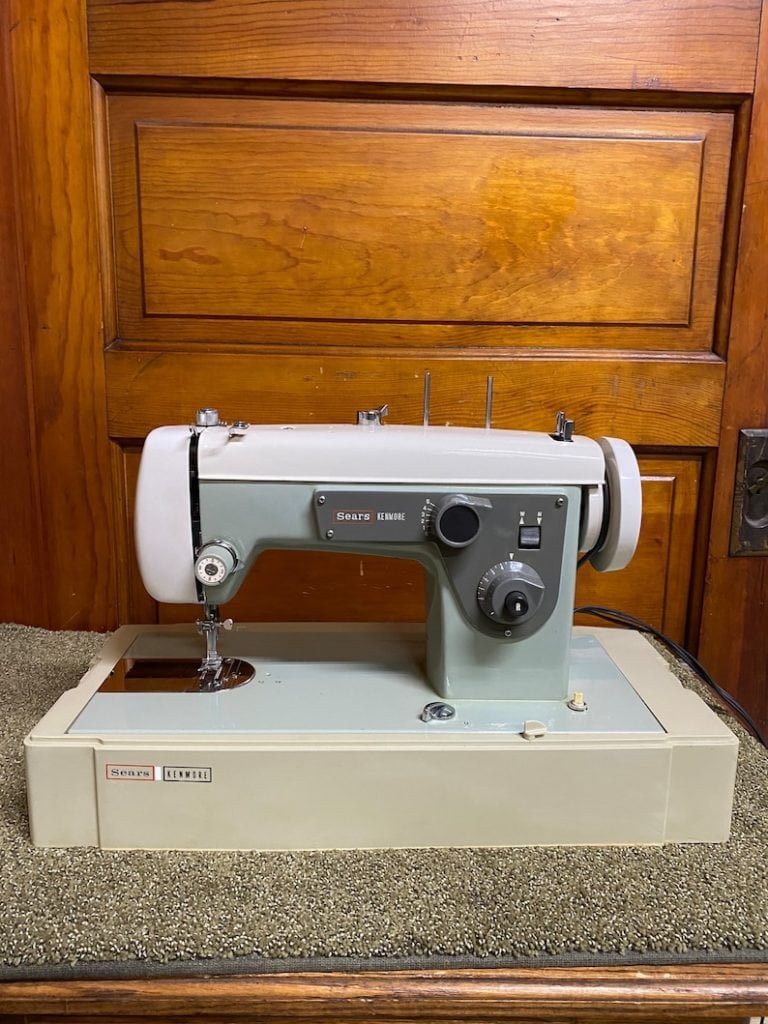
Fully restored and ready to use, this Sears Kenmore machine comes in the original green & white packaging. The original sewing feet and bobbins are included, as well as the pedal, cord, and case.
6. Fleetwood Industrial Machine 1093-TW
Year: 1960s
Color: Brown
Features: Electric
Condition: Functional
Price: $150
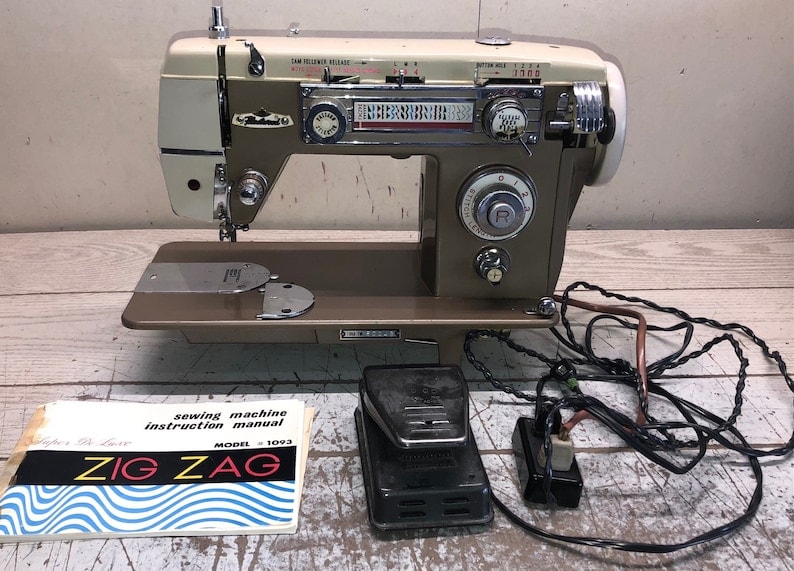
Another Japanese-origin machine, this one is an industrial model. It has a few more signs of wear-and-tear than most the machines from this age, so presumably it has been well-used.
7. Singer 477 Machine
Year: 1970s
Color: Off-white
Features: Electric
Condition: Functional
Price: $129
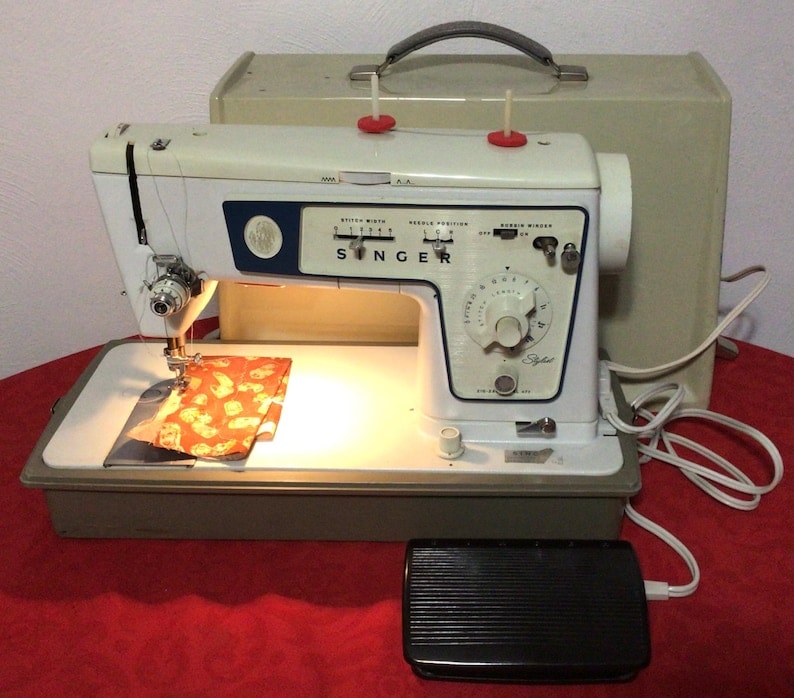
All the pieces are accounted for on this machine, from the sewing head itself to the pedal, electrical cord, and case. It is in good condition, entirely functional, and features zig-zag stitch capabilities.
8. Singer Stylist 814
Year: 1982
Color: Off-white
Features: Electric
Condition: Functional
Price: $200
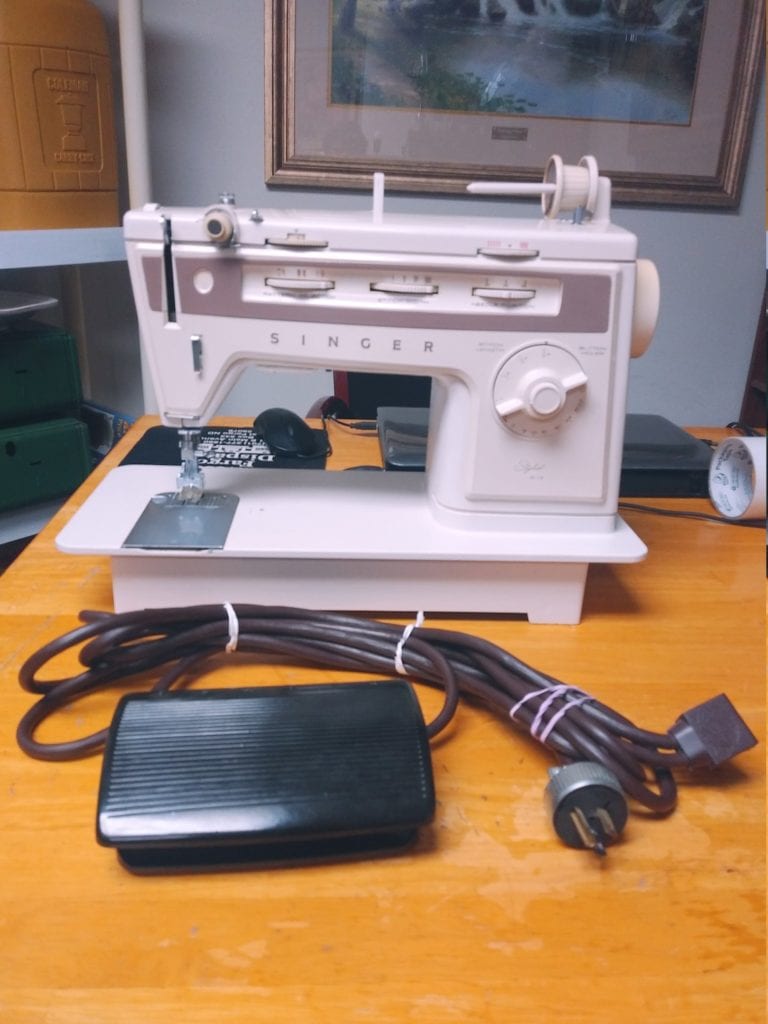
In an unusual twist for vintage machines: this one doesn’t seem to have been used (except for a functionality test before it was listed). This is a brand-new, high-end machine from the 1980s ready for work.
IX) Vintage Sewing Machine Accessories
1. Rotary Tin Box w/ Greist brand attachments
Year: 1900s
Color: Black & Gold
Price: $54
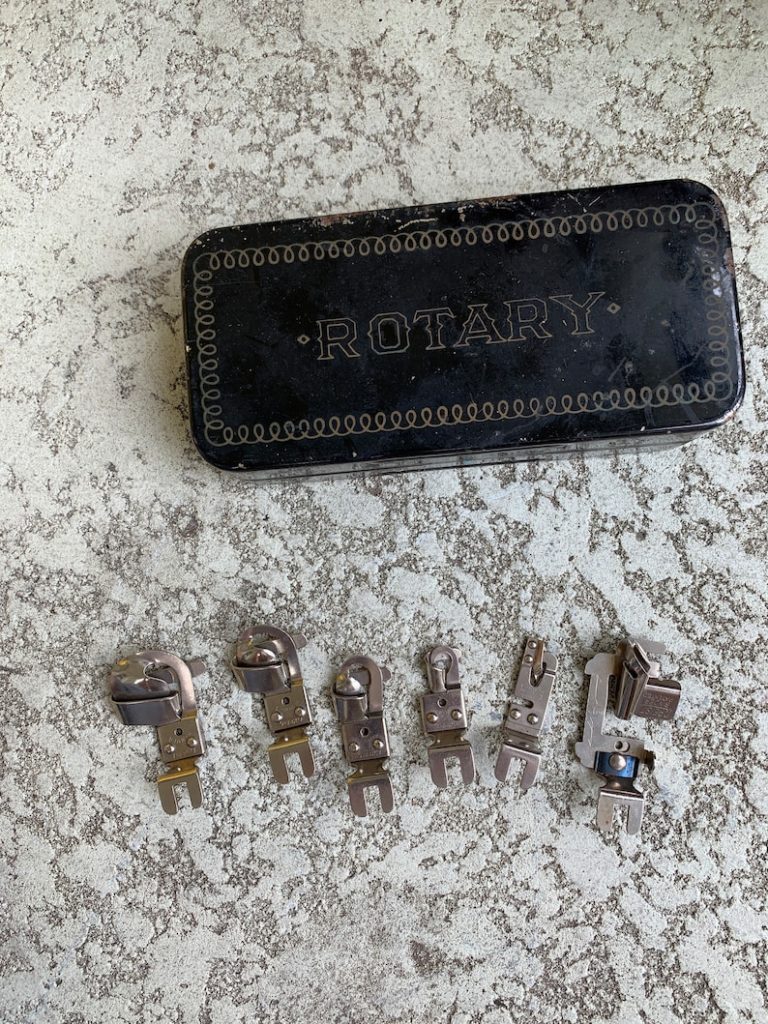
Four hemmer sewing machine attachments, a braider foot, and a binder in a small tin box. Greist was a third-party manufacturer for Singer, so it is most likely a safe guess that these attachments will fit period Singer machines.
2. 18 Zig-zag Cams
Year: 1950s
Color: Green
Price: $20
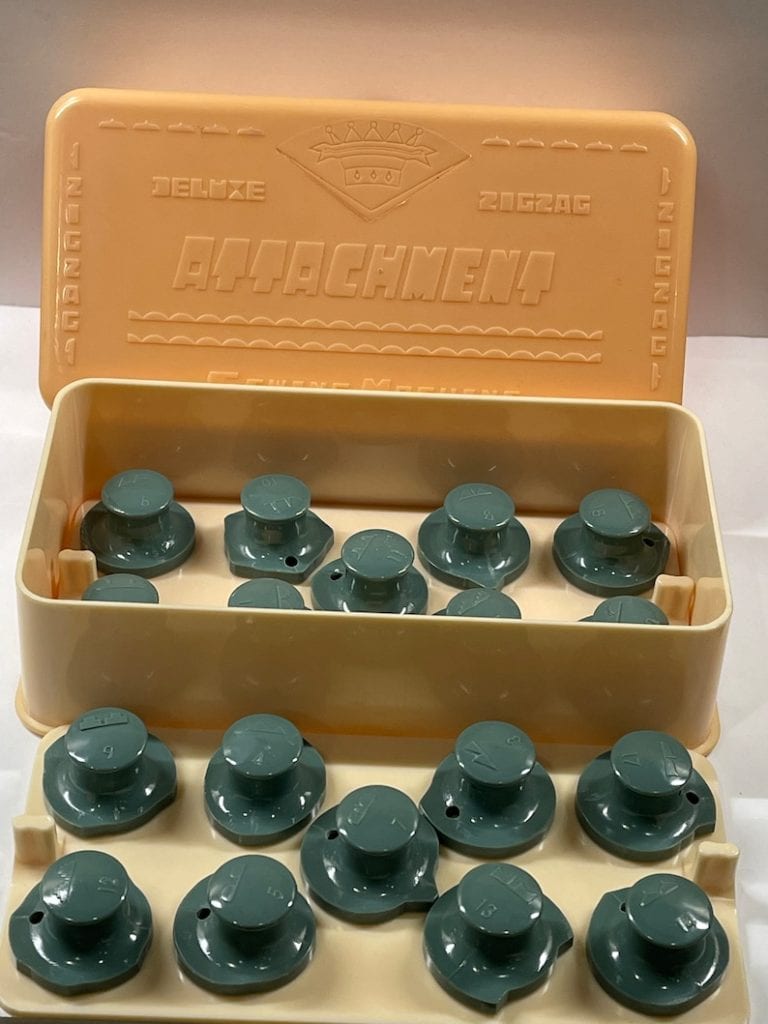
These cams are in functional condition, ready to be paired with your sewing machine—if they’re a match! (Be sure to check that first, they won’t fit every machine…)
Advantages of buying one
Vintage machines carry certain benefits over more recent models, such as …
- Durability: vintage machines are largely wood and metals that last
- Easy fixes: some oil or replacing basic gears, belts, or cords are the usual fixes.
- Ease of use: straightforward options and operation make it easy to get to sewing.
- Joy of the hunt: the possibility of finding a gem of a machine at a steal of a price.
History of the Sewing Machine
In 1790, Englishman Thomas Saint made history by inventing the sewing machine—unfortunately, he failed to advertise it very well. His design died in the Patent. Over the next half-century, between 1804-1842, numerous patents for sewing machines were filed across Europe as inventors kept pushing the envelope with this new machinery.
In 1844, John Fisher integrated all the best innovations to-date into his new design for a sewing machine. Unfortunately, he botched the patent filing. Elias Howe made a similar invention the next year, except that he fed the fabric vertically. He successfully filed his patent which would come in handy six years later, when Isaac Singer came on the scene.
Singer basically copied Fisher and Howe. Howe instigated and won a court case, gaining $1.50—about $15.75 today—on every Singer machine produced. Intellectual property theft (and resulting court cases) in the sewing machine industry continued throughout the next five years, in what came to be known as the Sewing Machine Wars.
The resolution: in 1856, the top four sewing machine brands in America, including both Singer and Howe, formed a conglomerate. They pooled their individual patents and began charging $15 (around $150.55 in 2021) per machine to other companies wanting to use any of their innovations.
By 1887, all the conglomerate’s patents had expired. The next major change to the industry was in 1889, when Singer invented the electric sewing machine—simplifying the process from the previous hand-crank or foot-powered machines. By 1918, the electric sewing machine was in wide use, both in homes and industry … and Singer was spending over $1 million a year on advertising.
Sewing machines continued to differentiate into other handiworks (such as crochet and embroidery) throughout the 20th century. Although the industry did face lulls as wartime necessity rerouted production materials, like metals and plastics, to military factories instead, there were always rebounds after and the industry remains strong.


